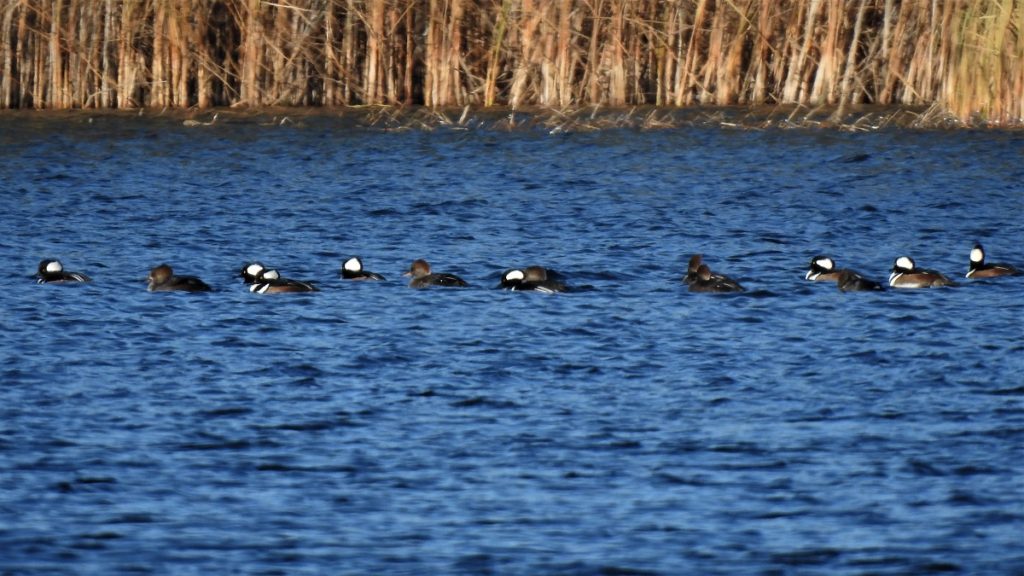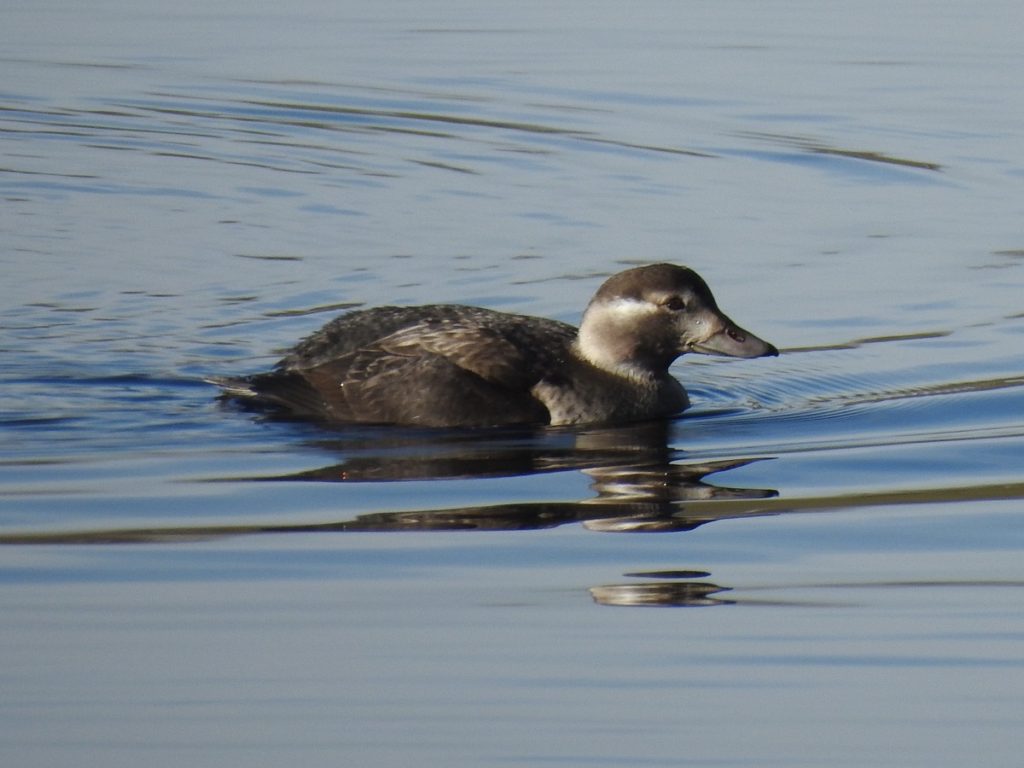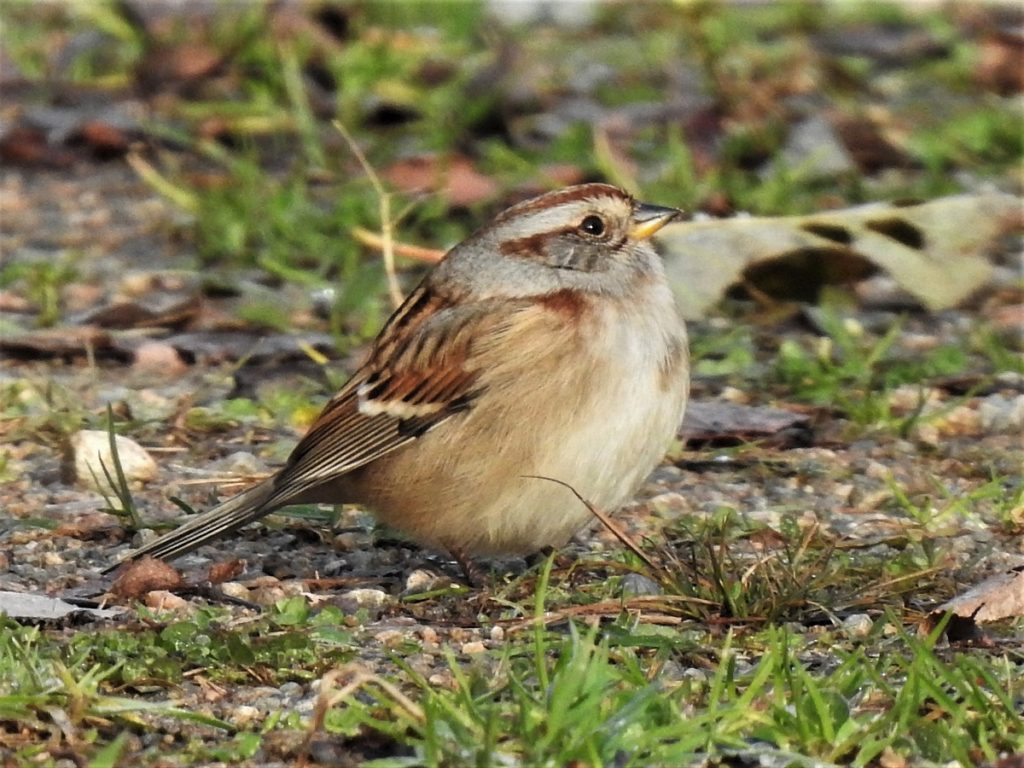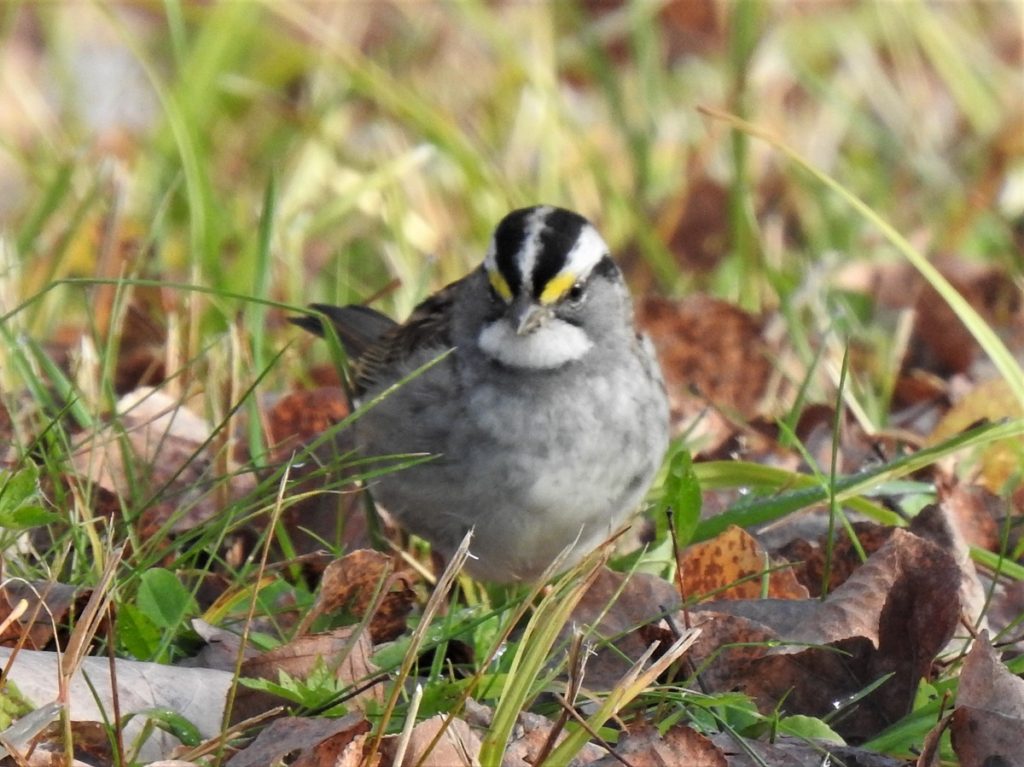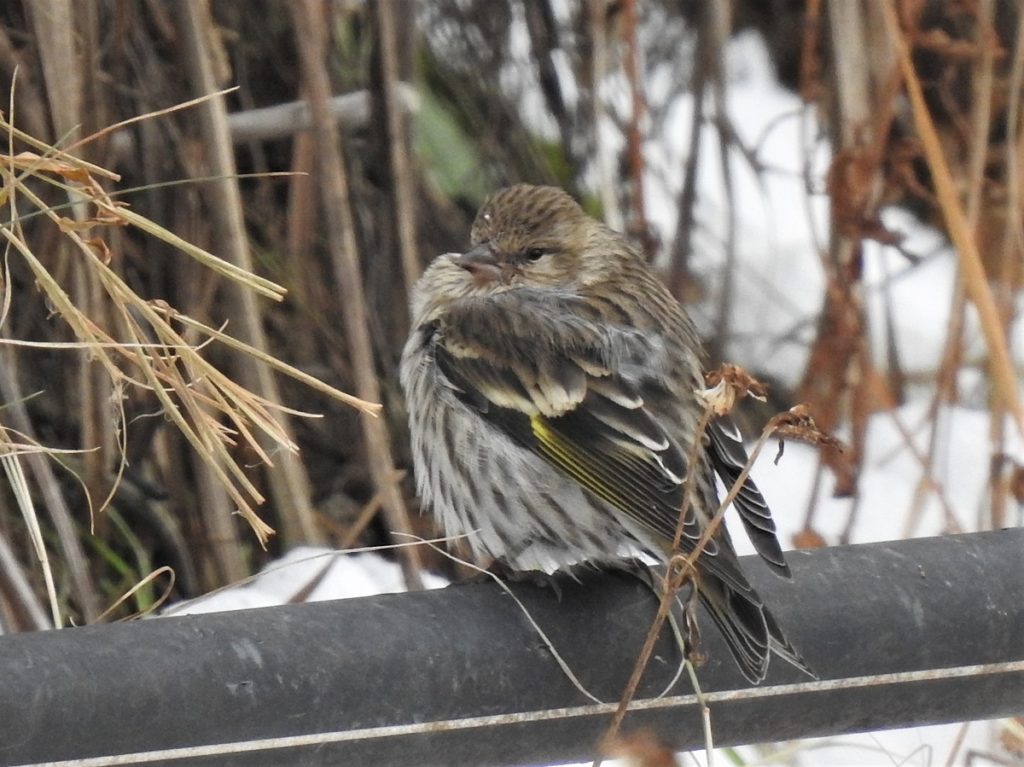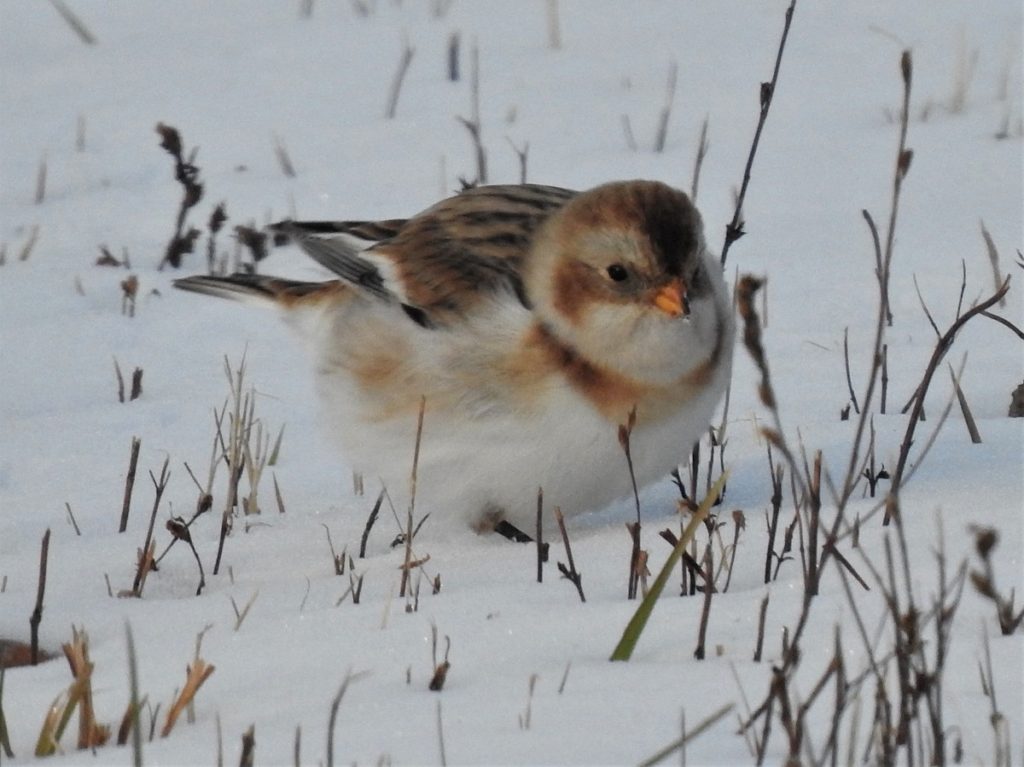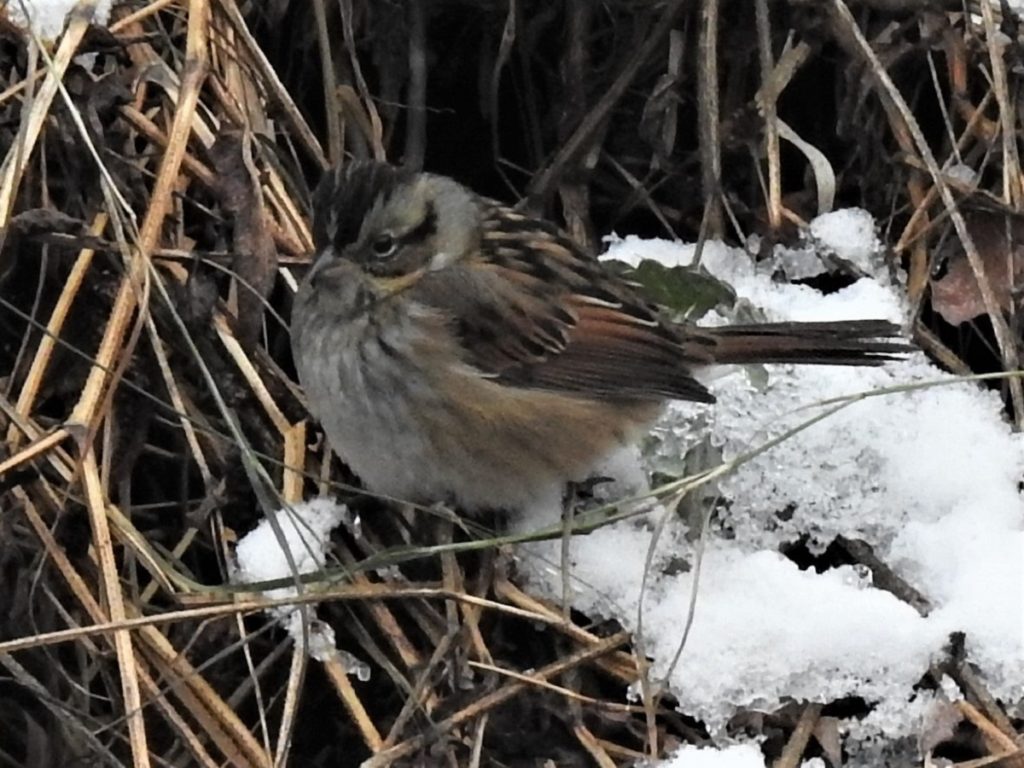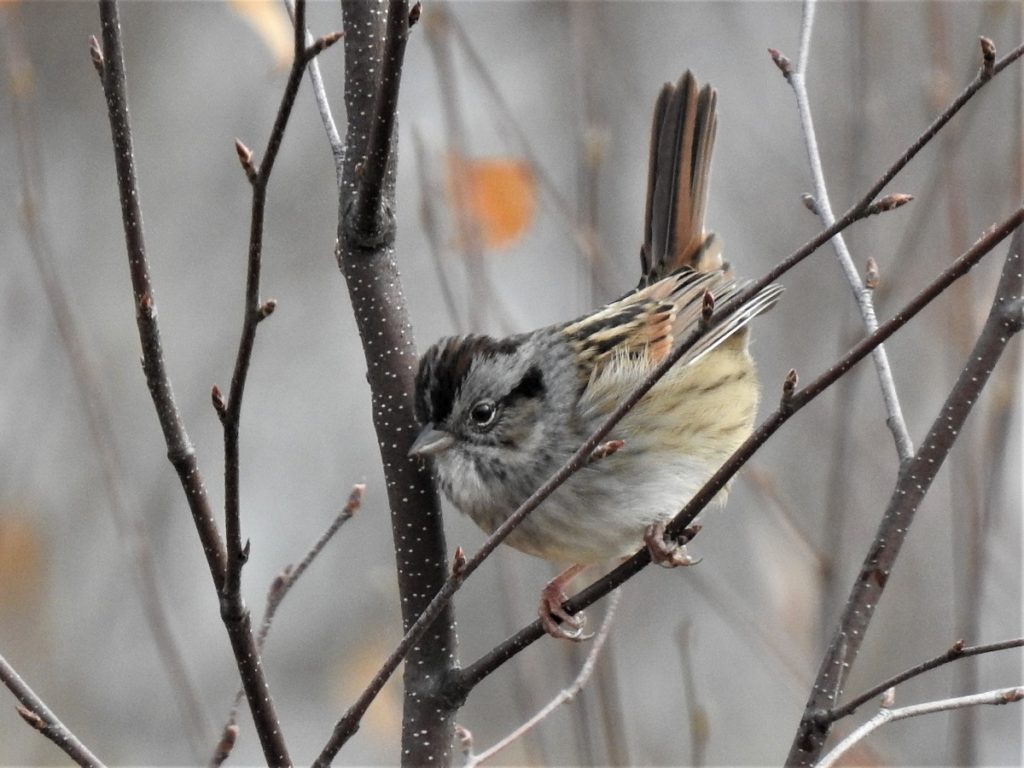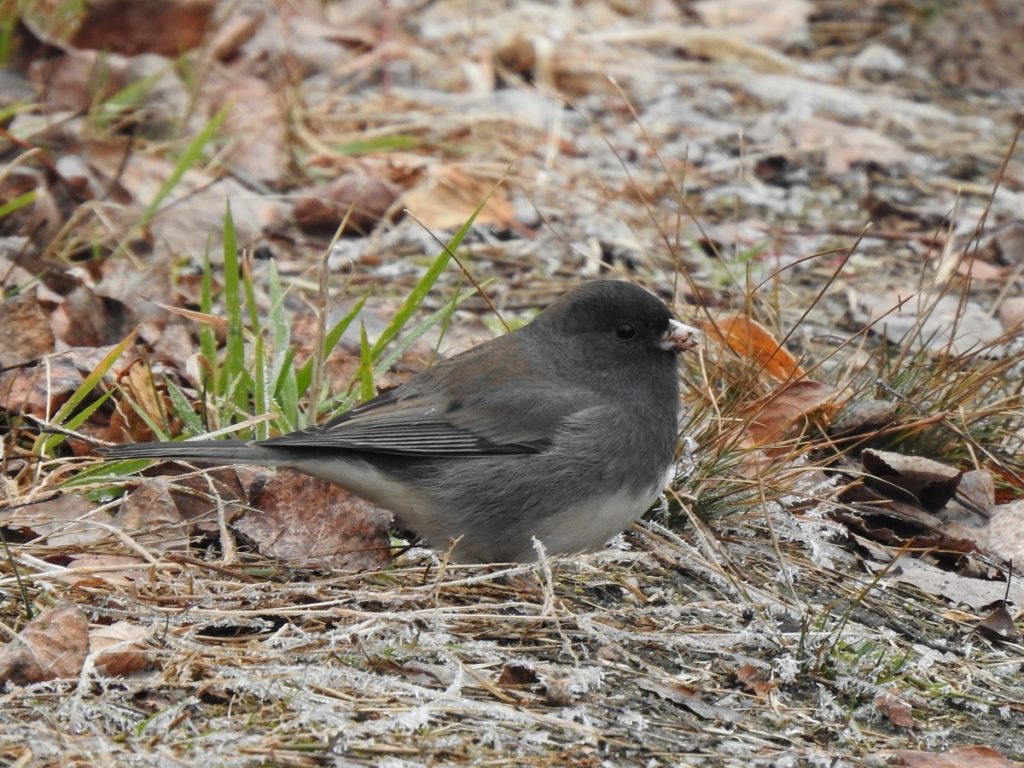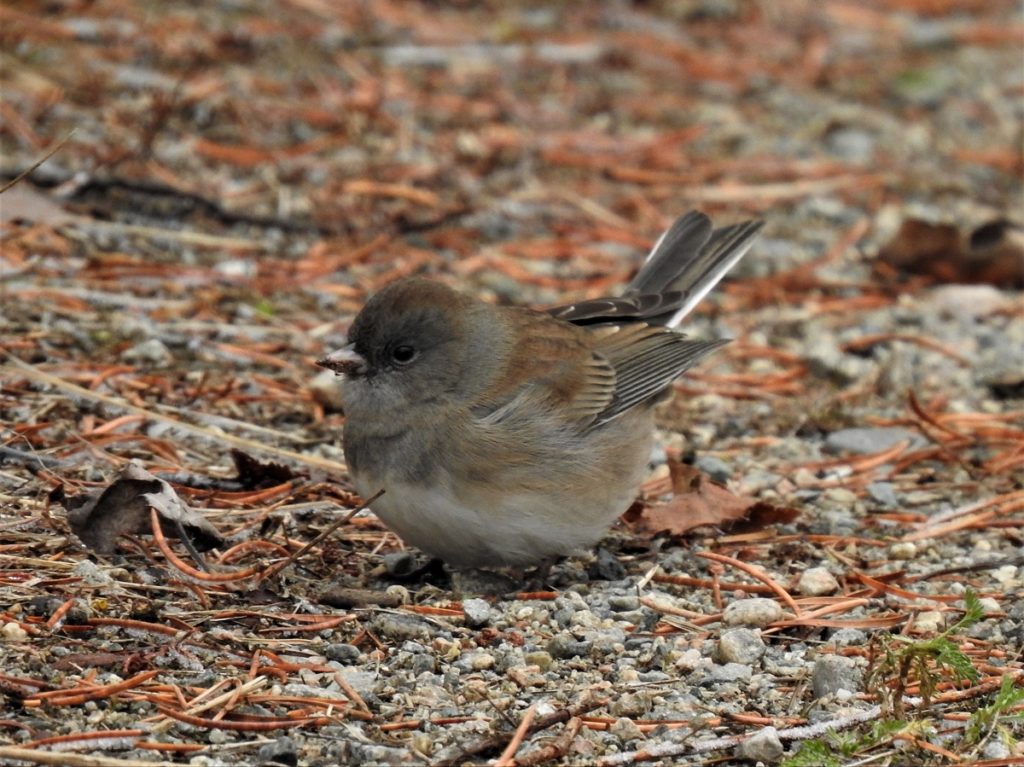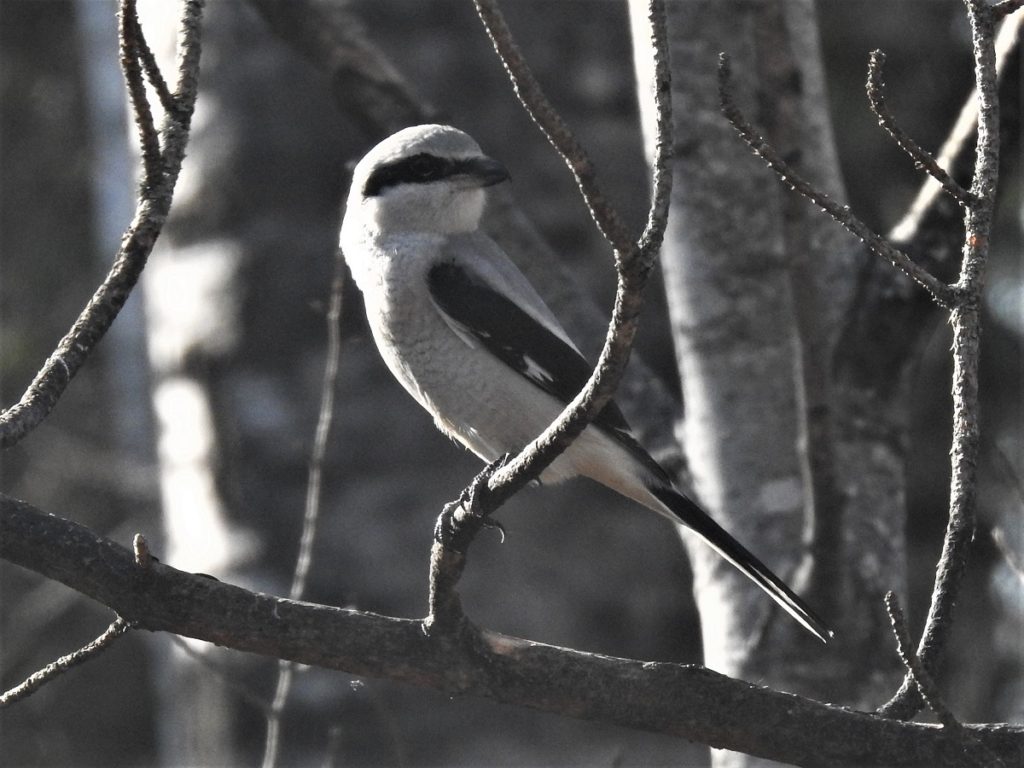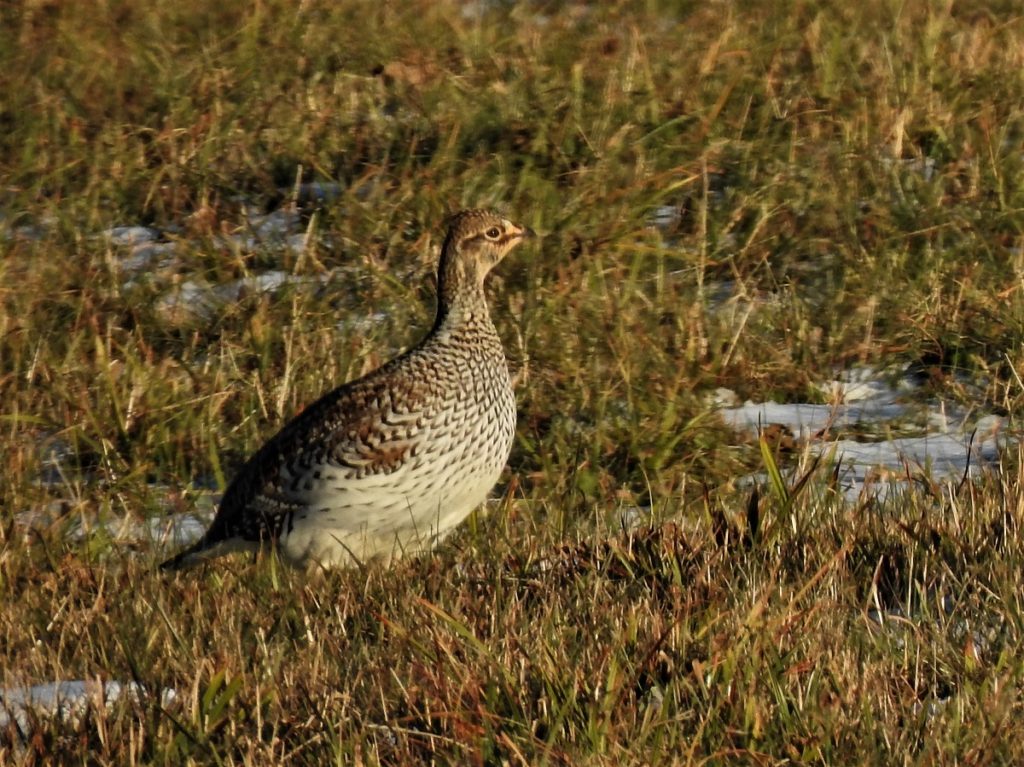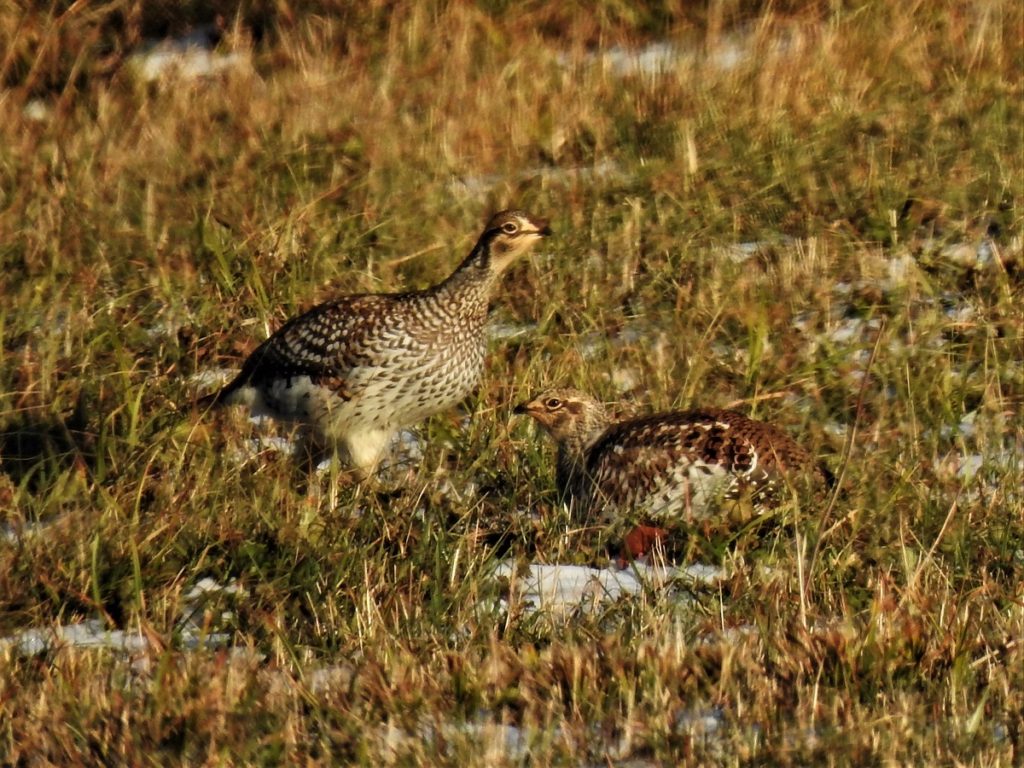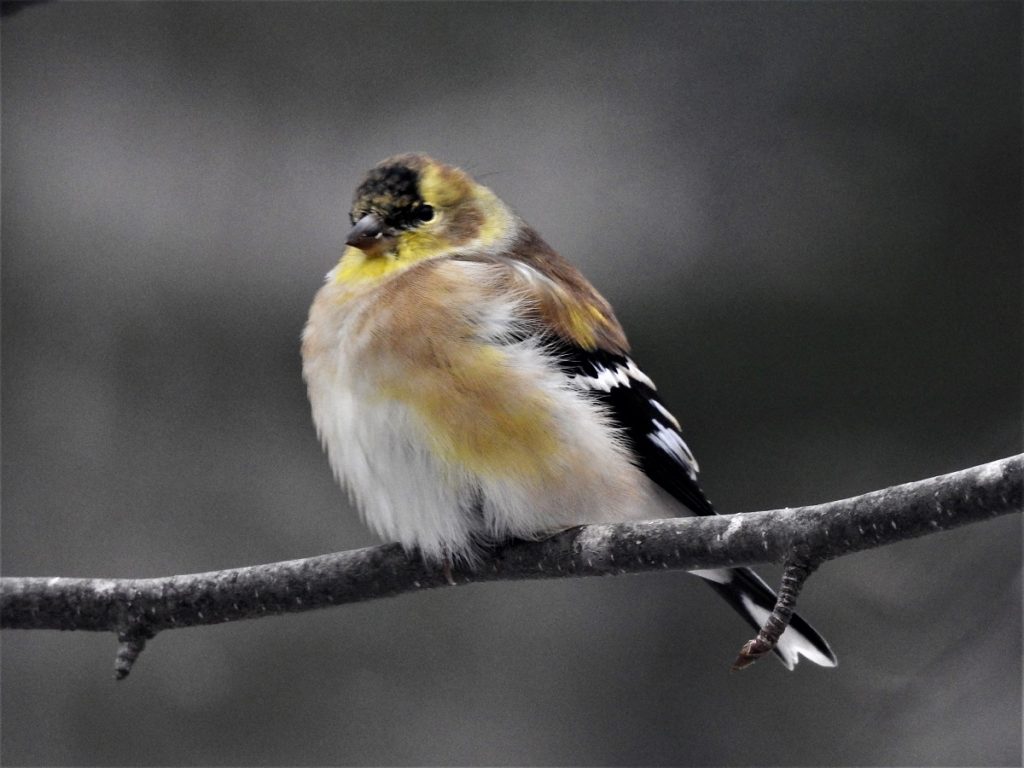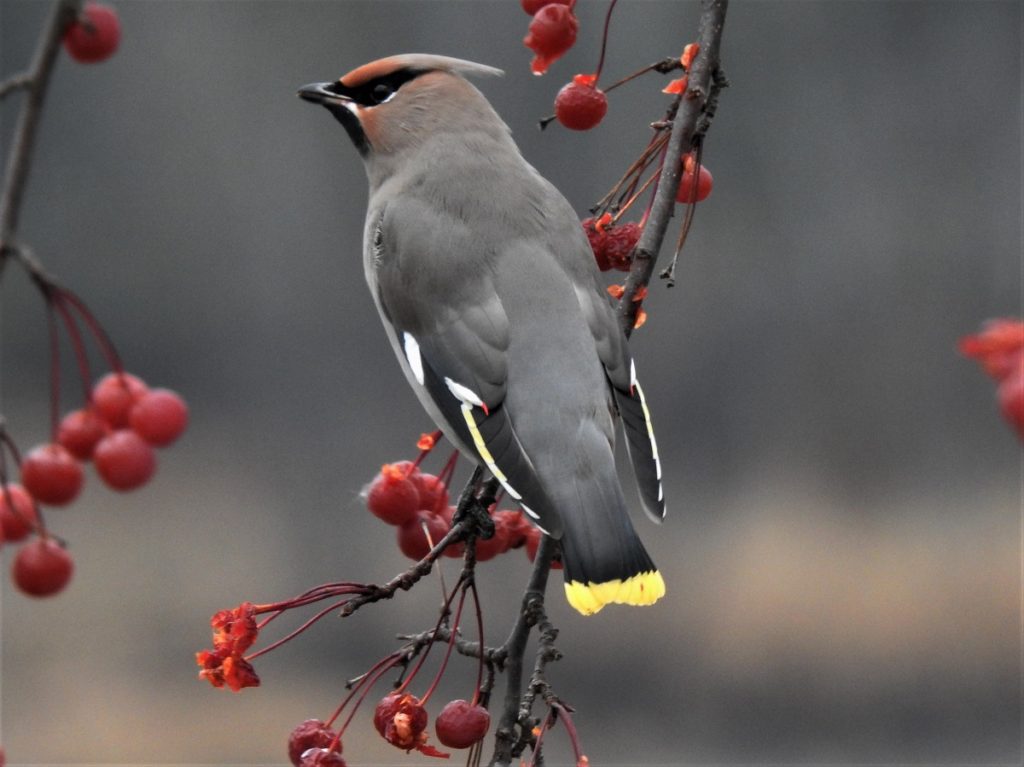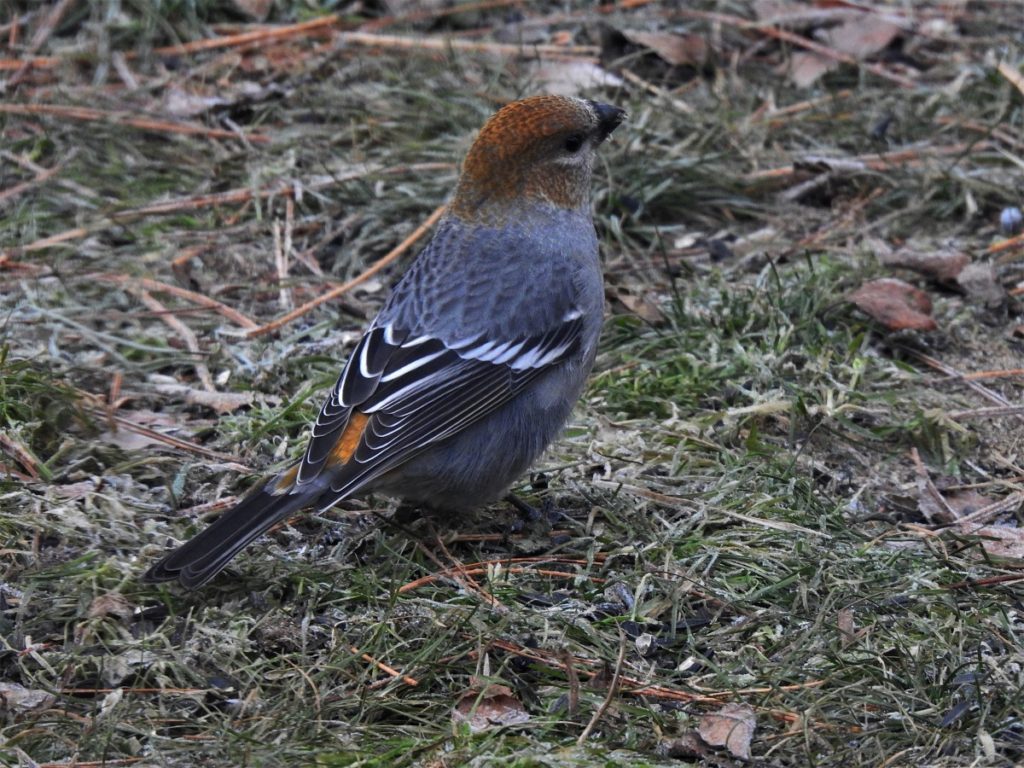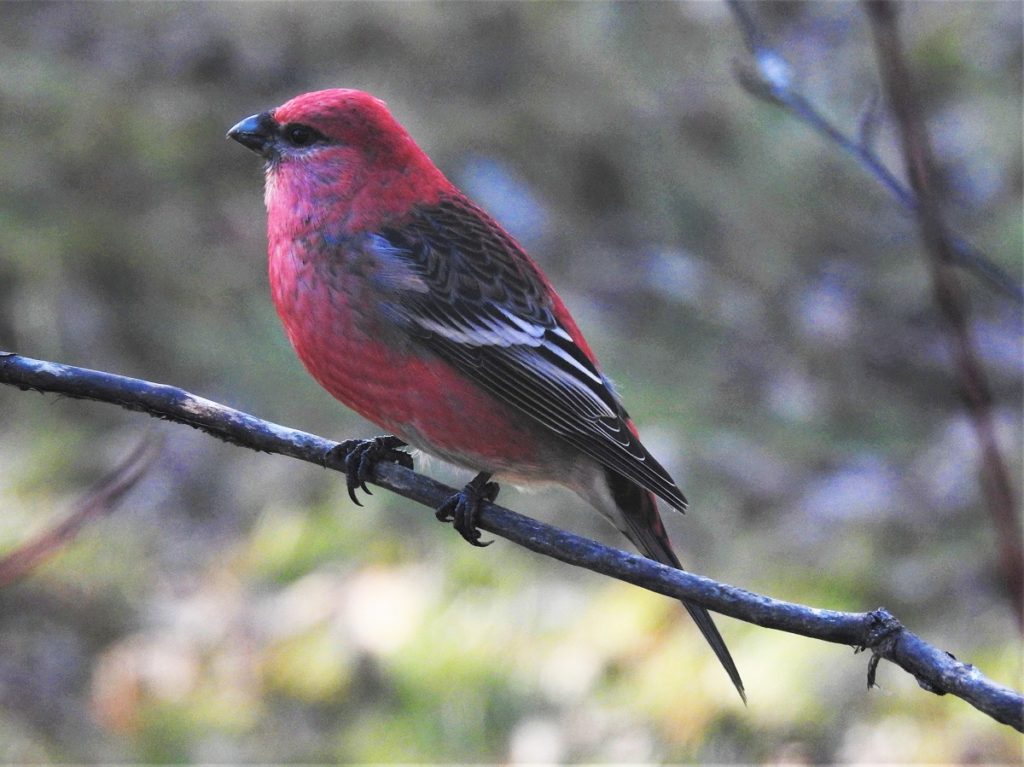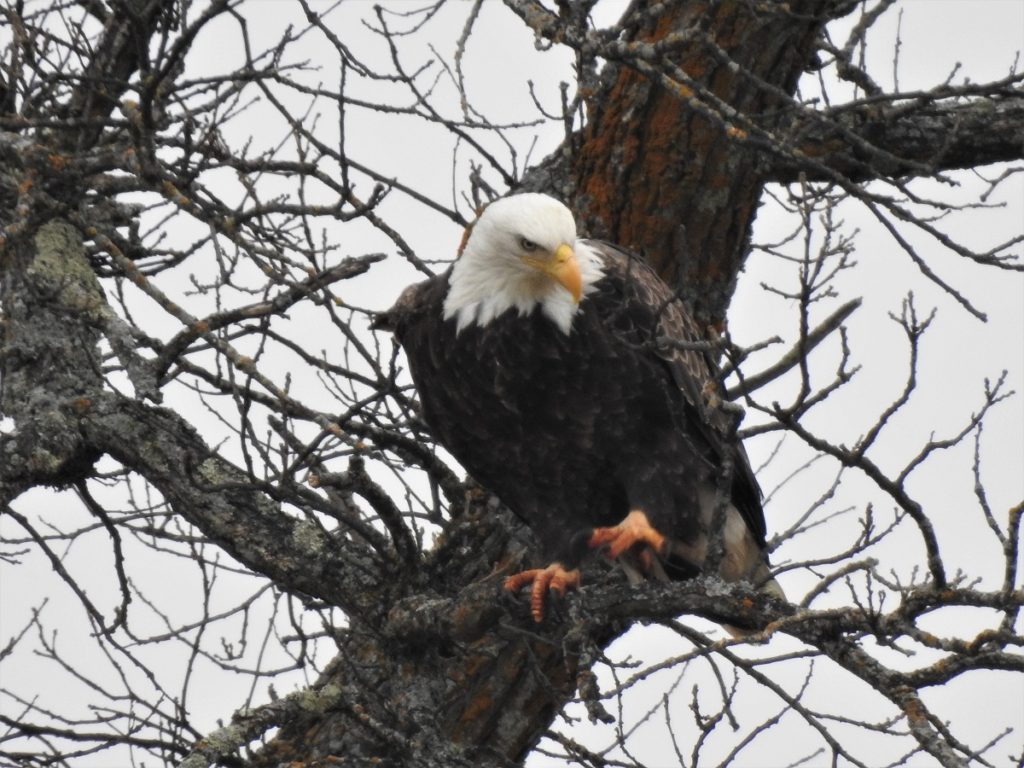Tales From the Wild Side
Fall 2020
Board of Directors
President Ilka Milne
Vice-President Mike Hammond
Secretary Gaby Emond
Treasurer Henry Van Ael
Committees
Newsletter Ilka Milne & Bob Saunders
Website Ilka Milne & Bob Saunders
Events Ilka Milne & Bob Saunders
Boardwalk Ahlan Johanson & Mike Hammond
Publicity Henry Miller & Ilka Milne
Stewardship Liaison Gaby Emond
President's Message
Hello Everyone! Last year we had high hopes for revitalizing the club. We started strong, with a public information session on the Christmas Bird Count at the Fort Frances Public Library, then a winter ski outing at Bob’s place. We created this website, had owl survey information sessions and summer field trips planned before the epidemic happened.
Well, we still have high hopes. In our fall general meeting we presented a big wish list of field trips for the coming year. We’re going to forge ahead on these. We can adhere to physical distancing and group gathering rules and change very little about what we do outside. And as far as public information sessions are concerned- whether they are about birding, dragonfly watching or whatever else we wish to be involved in- we’ll go ahead with these too if we have a safe venue. Maintaining our focus on the nature is how we can stay grounded in what is important to us and how we can also lead others to a healthy relationship with our world.
I’m so proud of this little club. We’ve kept afloat all these years on the hard work and dedication of a few people. We’ve always wanted more like minded folks with whom to share our passion for natural history, and sometimes it has been difficult to keep the faith that we’d find them. But in all this time we’ve kept going- maintaining our projects, volunteering, contributing, making a positive difference.
Just before the epidemic we were on the cusp of exciting growth. While it interfered with what could have been a stunning summer of field trips, the energy is still there. A few of us still got out on small informal outings or continued with personal projects. Over the summer some blue bird lines got a re-boot. Several new dragonflies were recorded for the district. The bog walk appears to have been very popular place for people to take a nature break.
We’ve seen that many people have grown a new awareness and curiosity about the richness of experience around them. Our club has so much to offer and we’re ready!
Poetry Corner
Nothing Gold Can Stay Robert Frost (1874 – 1963)

The Wild Swans at Coole William Butler Yeats (1865 – 1939)
The trees are in their autumn beauty,
The woodland paths are dry,
Under the October twilight the water
Mirrors a still sky;
Upon the brimming water among the stones
Are nine-and-fifty swans.
The nineteenth autumn has come upon me
Since I first made my count;
I saw, before I had well finished,
All suddenly mount
And scatter wheeling in great broken rings
Upon their clamorous wings.
I have looked upon those brilliant creatures,
And now my heart is sore.
All’s changed since I, hearing at twilight,
The first time on this shore,
The bell-beat of their wings above my head,
Trod with a lighter tread.
Unwearied still, lover by lover,
They paddle in the cold
Companionable streams or climb the air;
Their hearts have not grown old;
Passion or conquest, wander where they will,
Attend upon them still.
But now they drift on the still water,
Mysterious, beautiful;
Among what rushes will they build,
By what lake’s edge or pool
Delight men’s eyes when I awake some day
To find they have flown away?
Fall Birding Trip

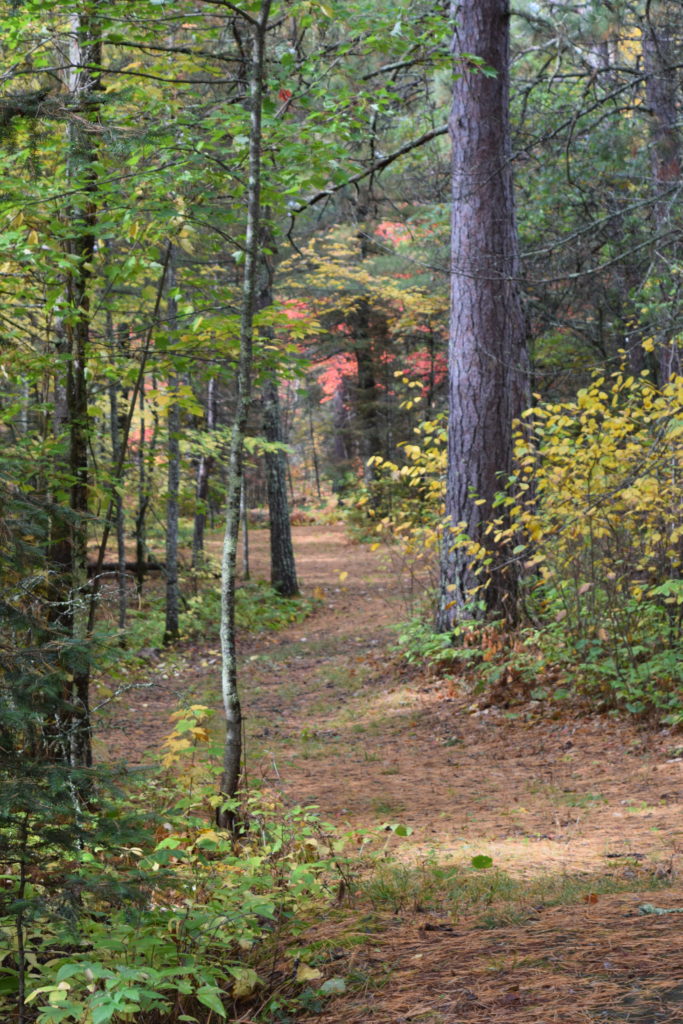

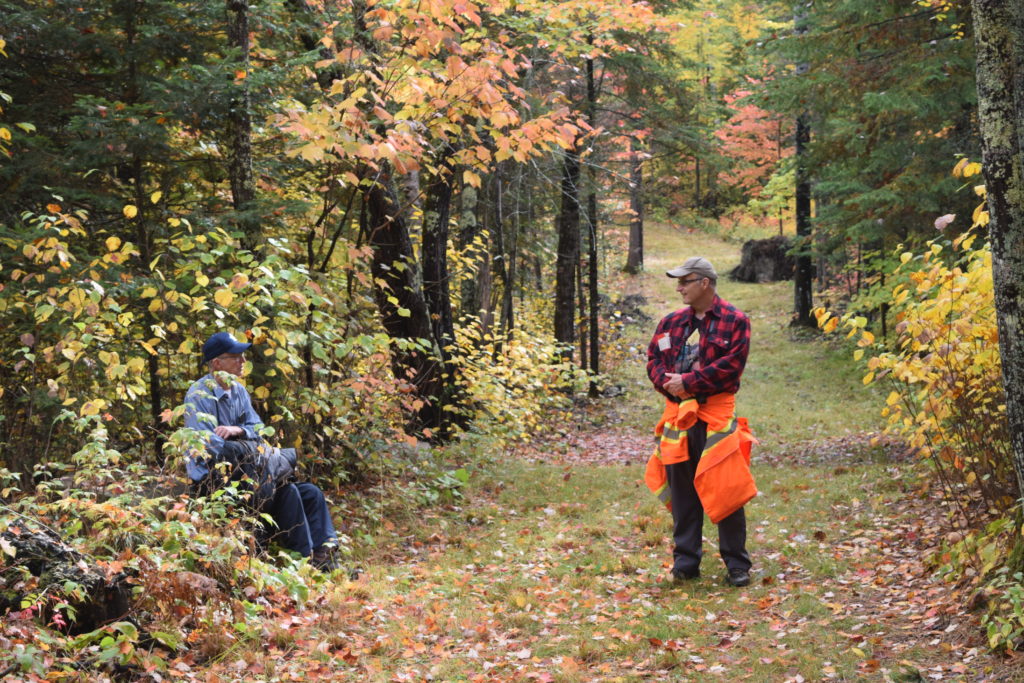
List:
- 41 Canada Goose
- 7 Blue-winged Teal
- 8 Mallard
- 1 Common Goldeneye
- 9 Red-breasted Merganser
- 3 Rock Pigeon
- 50 Ring-billed Gull
- 1 Common Loon
- 2 Turkey Vulture
- 2 Bald Eagle
- 1 Yellow-bellied Sapsucker
- 1 Downy Woodpecker
- 2 Hairy Woodpecker
- 1 Pileated Woodpecker
- 1 Northern Flicker
- 1 Warbling Vireo
- 4 Blue Jay
- 11 American Crow
- 6 Black-capped Chickadee
- 2 Ruby-crowned Kinglet
- 1 Red-breasted Nuthatch
- 1 White-breasted Nuthatch
- 5 European Starling
- 1 Hermit Thrush
- 8 American Robin
- 1 Chipping Sparrow
- 11 Dark-eyed Junco
- 15 White-throated Sparrow
- 2 Savannah Sparrow
- 1 Song Sparrow
- 15 Yellow-rumped Warbler
Participants: Ahlan Johansen, Randy Spritt, Henry Van Ael and Ilka Milne.
We met at river side of Point Park 8am on Saturday Sept. 26, scouted for water birds and songbirds in the bushes. It seemed that quite a few sparrows and warblers were moving through the bushes along the train tracks. We relocated to the lake side and spotted some ducks and followed them to the dock at The Rendezvous. There we found a Common Goldeneye and a small flock of Blue-winged Teal all in their winter plumage. Behind them, a Common Loon, also in winter plumage.
We then visited an island on the causeway, where we found Red-breasted Mergansers and more songbirds. Everywhere we went were many White-throated Song Sparrows and Yellow-rumped Warblers- but on the island we also found two Savannah Sparrows and another interesting find there was a Warbling Vireo. We probably missed a few species there, as birds were moving very quickly and the traffic made hearing their calls challenging.
This was unusual habitat for both the vireo and the Savannah Sparrow, but this was another place where we concluded we were seeing birds on the move and that islands on the causeway and the point are places where migrating birds might be funneled through on their way across Rainy Lake.
Our next stop was Rocky Inlet Ski Trails. Near the lodge at the start of the Beaverpond Loop we met Ruby Crowned Kinglets (well they were high in the canopy, but they said ‘hello’). The trails turned out to be much less busy than our previous stops. We did find a Bald Eagle and several Turkey Vultures perched next to the trail, a Northern Flicker, the usual woodpeckers and a Hermit Thrush. The colours there were stunning- with the red maple, mountain maple and sumac at the height of brilliant red or purplish red against a background of orange and yellow from the poplar and oak.
From the trails we then boated out to Randy’s place Nowhere Island. He has many feeders, which attracted sparrows, nuthatches and blue jays.
We were back on the mainland around 2pm and not long after that the weather turned and wind picked up. Perfect timing!
In all we recorded 32 species during the trip (we’re not counting the farm country birds we saw on the way- but there are still Sandhill Cranes, Cowbirds, Belted Kingfisher, Magpies and Bluebirds in Alberton).
Autumn Leaves

Plant leaves have several types of pigments that together produce the colours we see. By far the most common pigments are a type of porphyrin, chlorophyll a and chlorophyll b, which together convert sunlight into food through a process called photosynthesis. There is so much chlorophyll in a leaf that it masks all of the other pigments, and because chlorophyll does not absorb green wavelengths, reflecting all of it, leaves appears green. In autumn, as temperatures cool and sunlight lessens, plants stop making chlorophyll, slowly reabsorbing those molecules so that they can be used the following year.
As the amount of chlorophyll decreases other pigments become dominant depending on the plant species. Most have a mixture of carotenoids and flavonoids; some, like aspens have mostly carotenoids, especially xanthophyll which produces a yellow colour, while oaks have mostly flavonoids, especially anthocyanin, which produce reds, blues, and purples; other plants have both anthocyanins and xanthophylls and will appear orange. Maples are capable of producing all possible shades of reds, oranges and yellows.
Other carotenoids include carotene and lycopene which produce yellows, oranges, and reds; other flavonoids are flavone and flavanol, which produce shades of yellow. So, depending on the amount of the various pigments in a particular species, autumn leaves may appear yellow, orange, red, or purple.
Light is not needed to produce carotenoids, and they are always present in plant leaves; therefore, as chlorophyll disappears and its green colour fades, mostly yellow appears. Anthocyanin is not as common as carotenoids. It helps protect those plants with it from being sun burned. It is composed of sugars and are therefore dependent on light to create those sugars. The combination of warm sunny days and cool nights provide the conditions needed for anthocyanin production.
Various other factors, including temperature, soil moisture and soil pH, and, most importantly, amount of sunlight interplay to produce the colours we see, their vibrancy, and how long they last. Lack of soil moisture may either delay the onset of colours or cause leaves to turn colour and drop during periods of extreme drought even before autumn is underway. Highly acidic soil produces reds; neutral and alkaline soils produce purples and blues. In a dense forest plants composed mostly of anthocyanins will have red leaves at the top of the tree where they receive more light, and more muted colours below.
The best conditions for producing beautiful fall colours are warm autumn days, cool nights, and sunny skies, with adequate moisture during the growing season.
In spring as daylight increases, chlorophyll production amps up, leaves turn green, and we wait for autumn once again to view the beautiful fall foliage we enjoy so much.
October Snow – A Photo Essay
Snow in October is not unexpected, and we are not surprised when the first flakes begin to fall, but we never are fully prepared for it, even if all the wood for winter has been split and stacked, snow tires mounted, snow plows and blowers readied, and the gardening tools put away. The colours of autumn have reminded us that summer is ending, but there is always the hope for a few more warm days that linger on. The first snow fall quickly dashes that hope, and we finally have to admit winter is approaching. For many that is a miserable thought and plans for a winter getaway to warmer climes are immediately made. But for me, winter is a beautiful season, one where we can pause and refresh, read those novels that for years we’ve been promising to read, and enjoy the activities that winter brings. The first snowfall reminds us of what beauty there is around us, even in the commonplace – we simply need to open our eyes and look.
All the photographs for this photo essay were taken on a cloudy morning, October 21, the day after the first snowfall of the season.



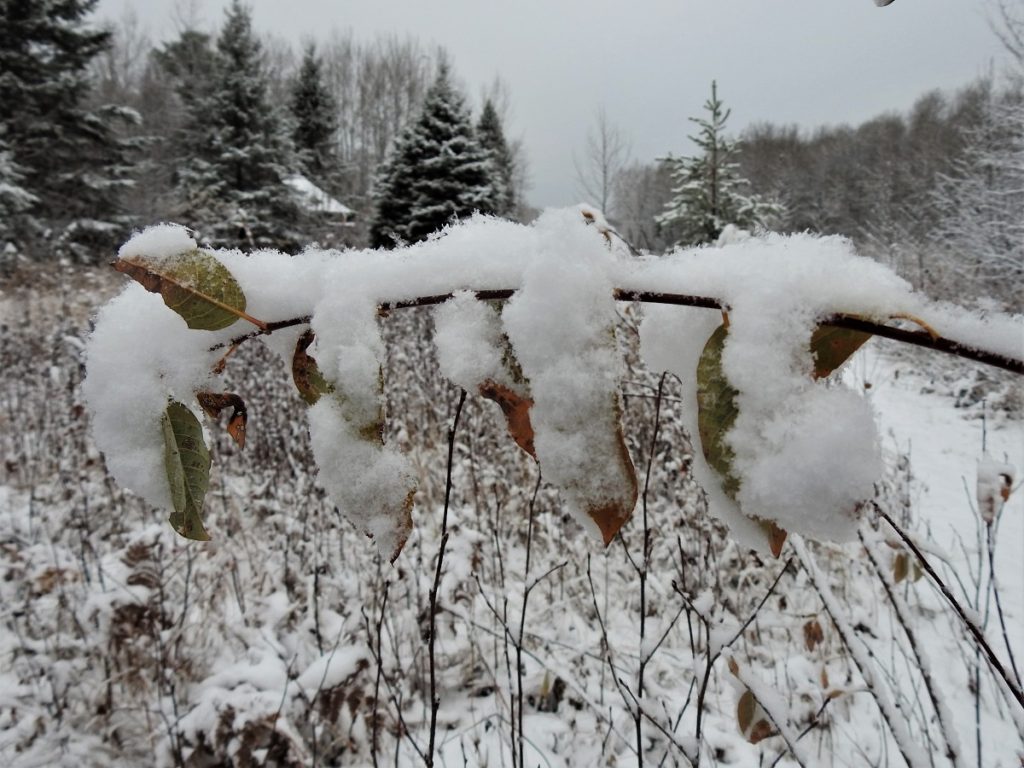
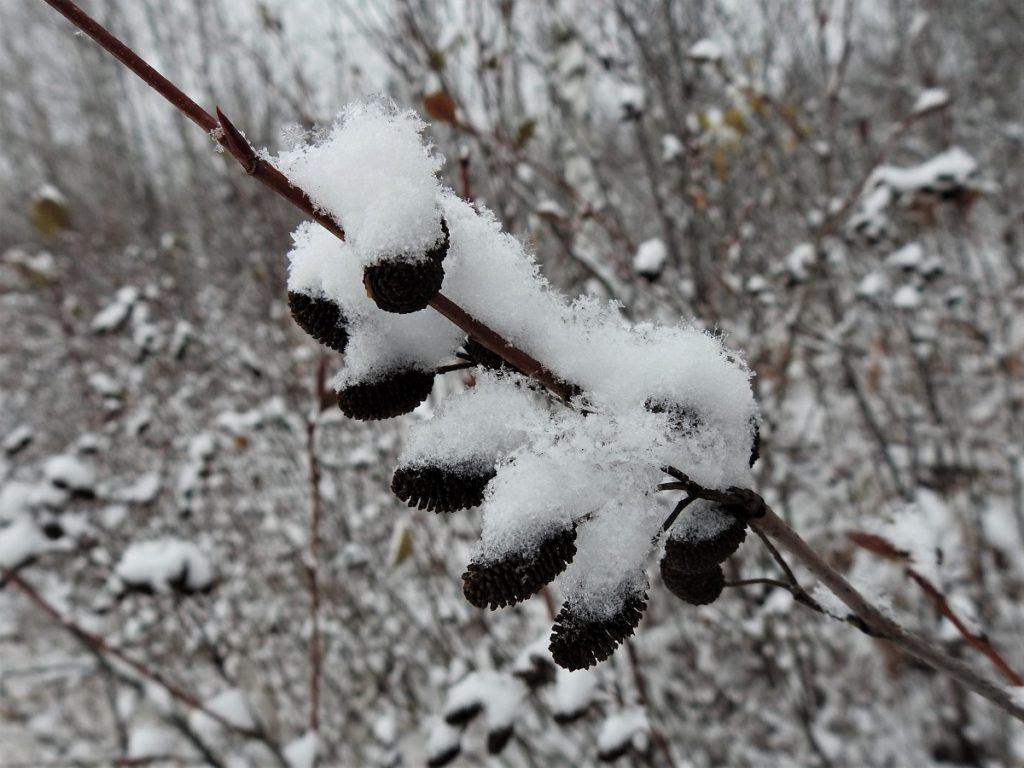
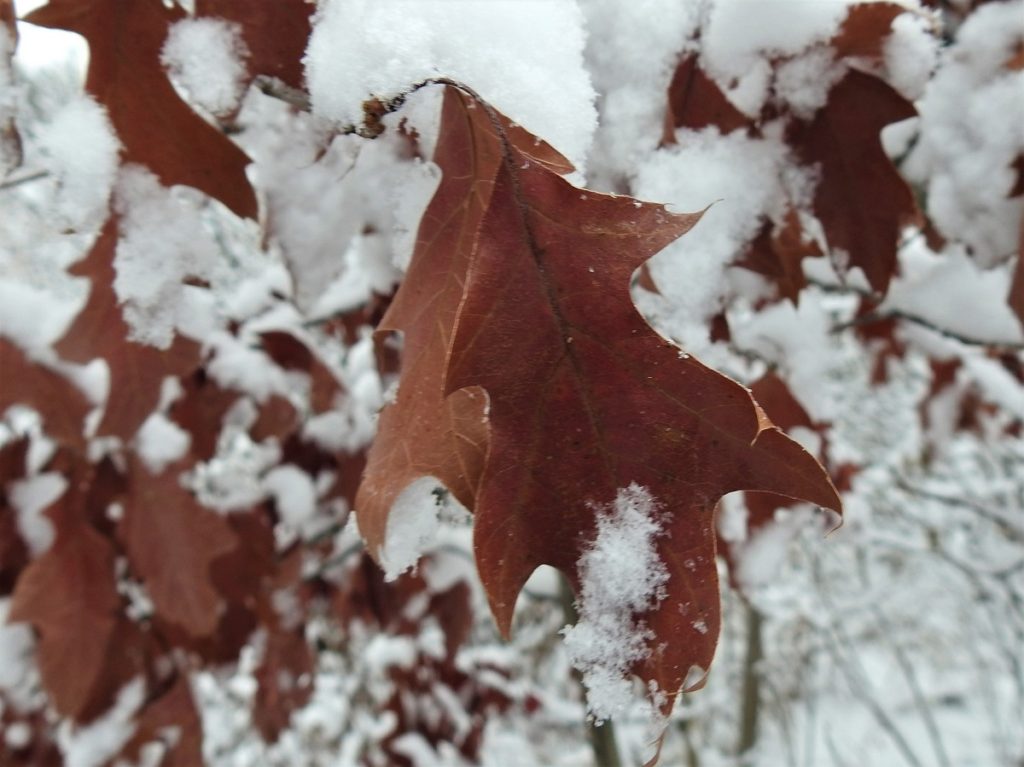
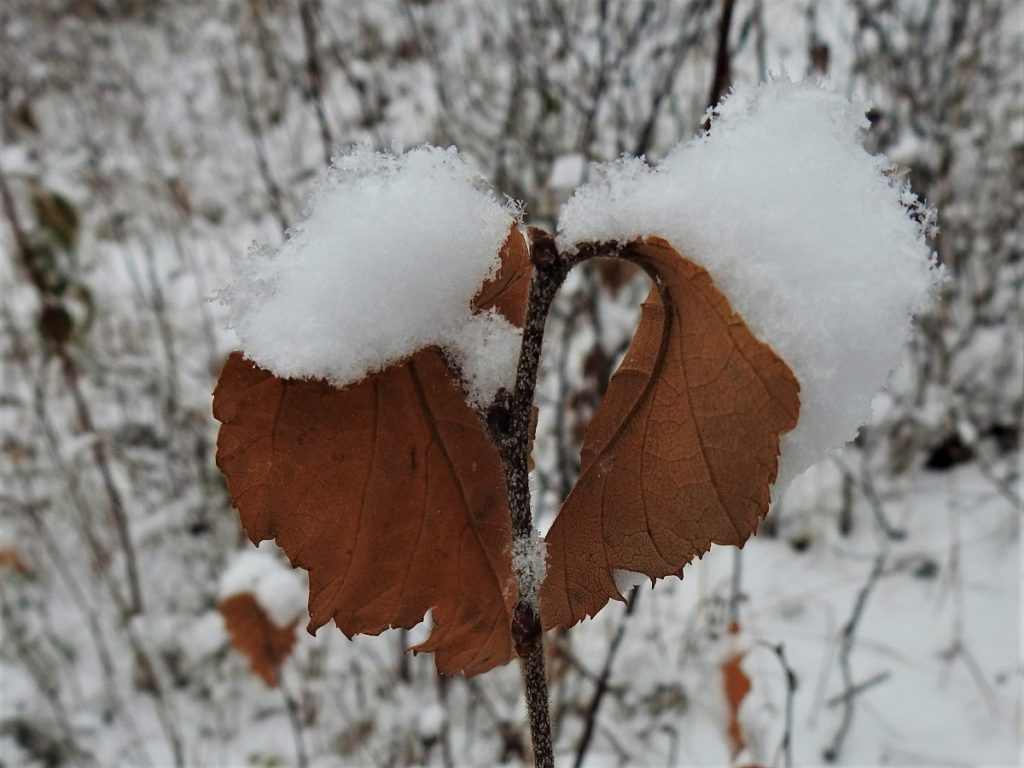

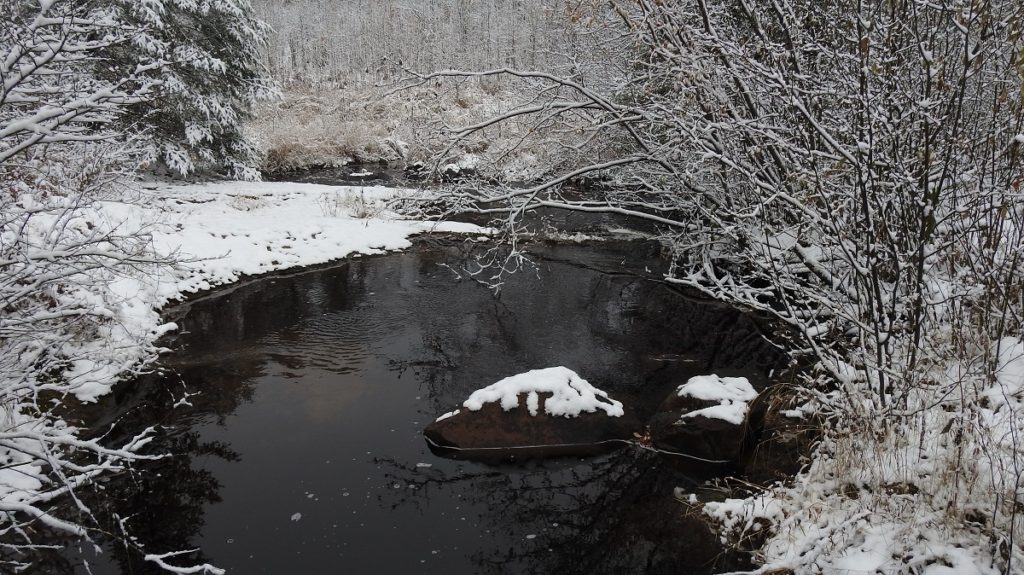
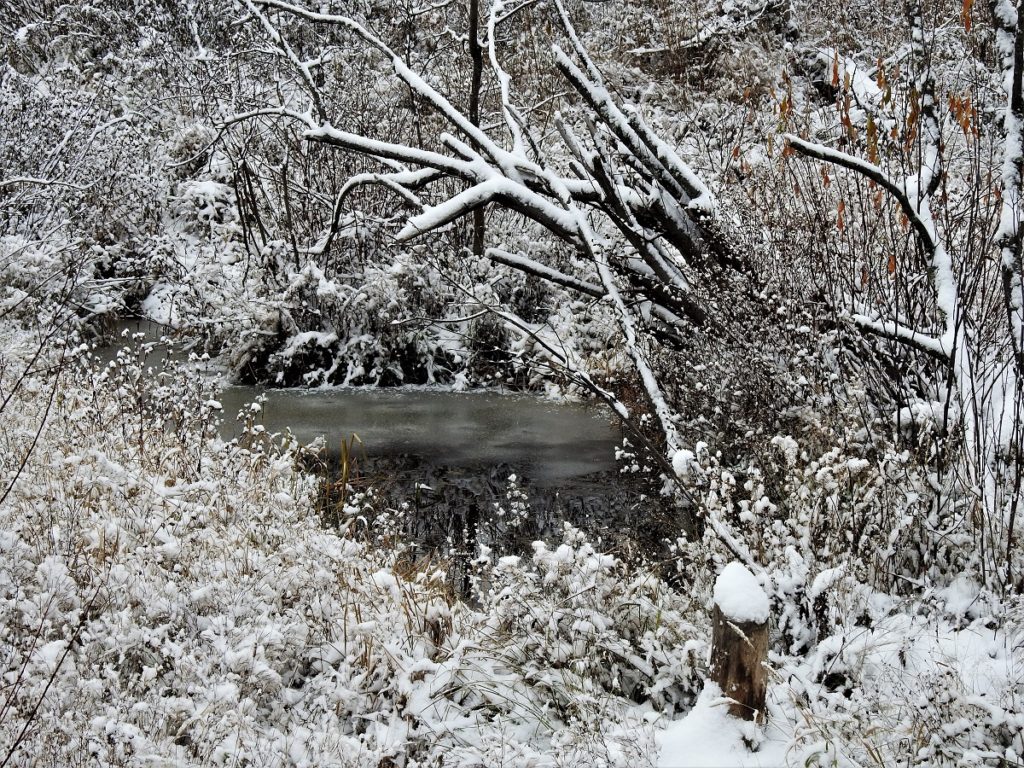
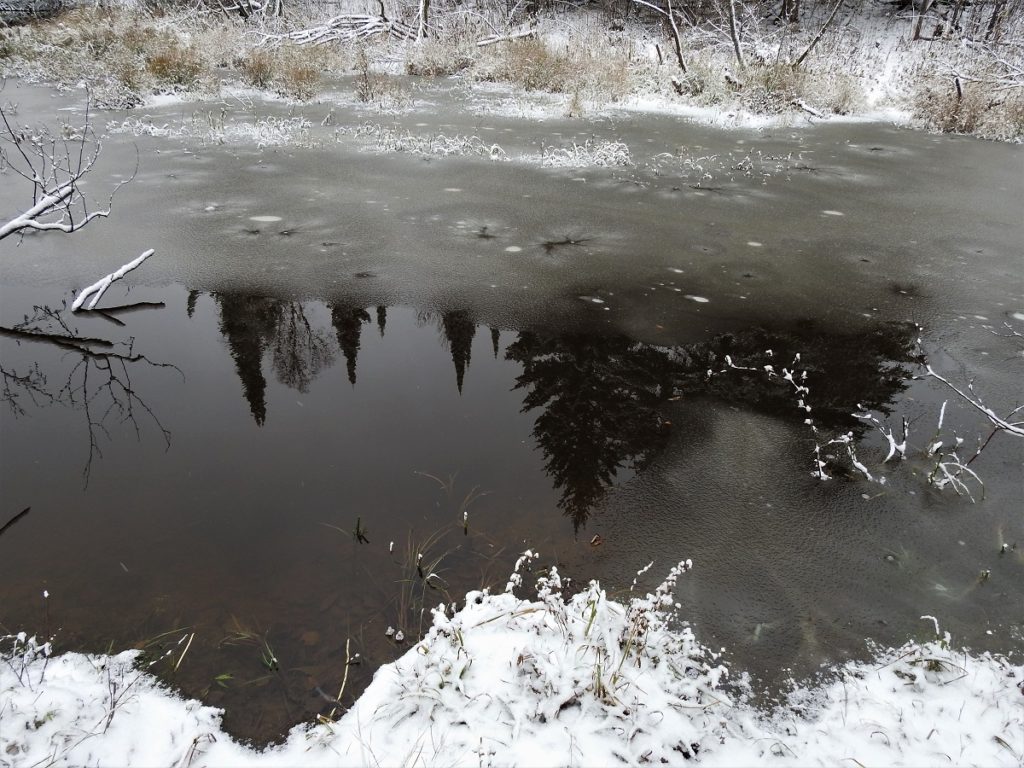
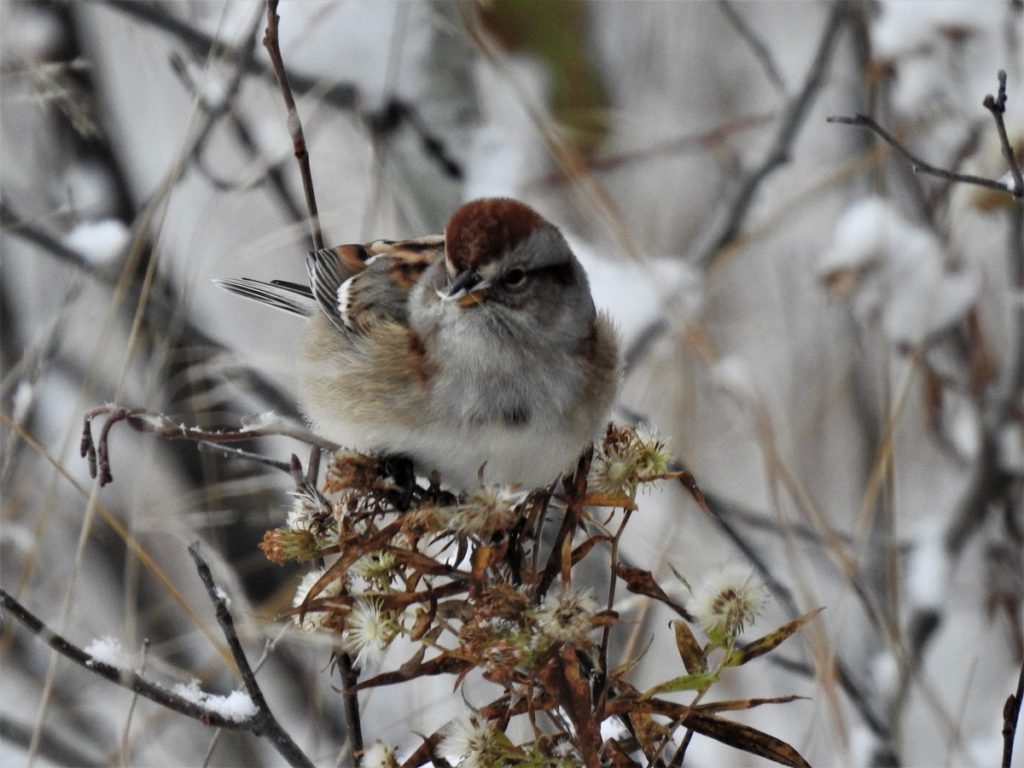

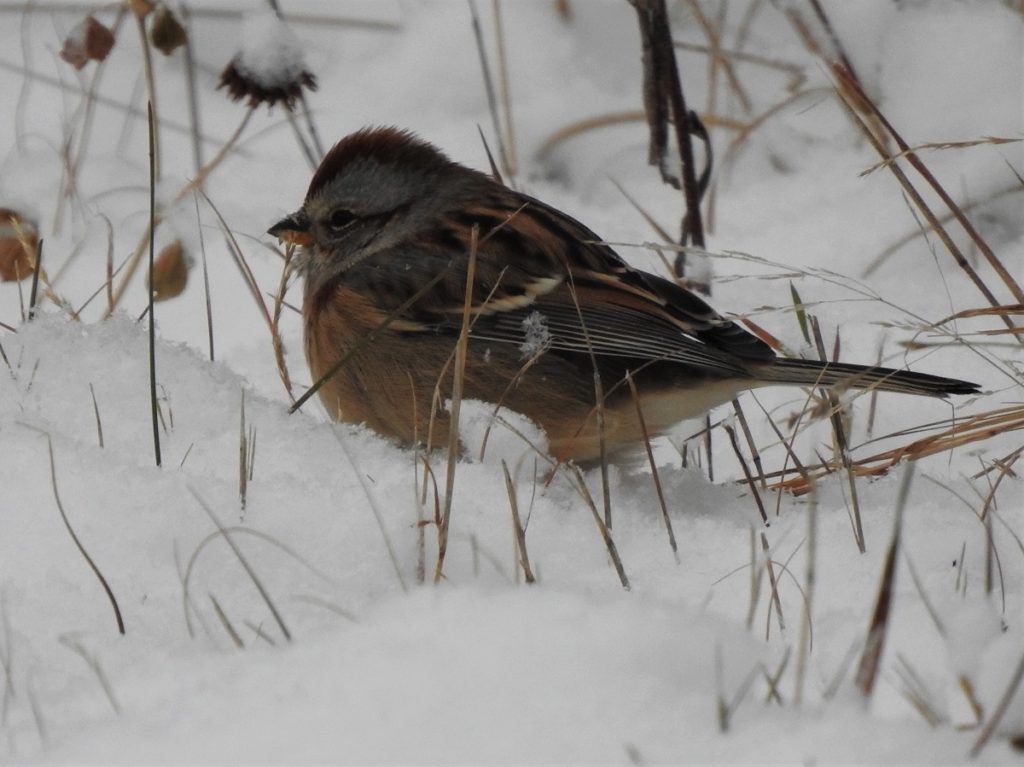






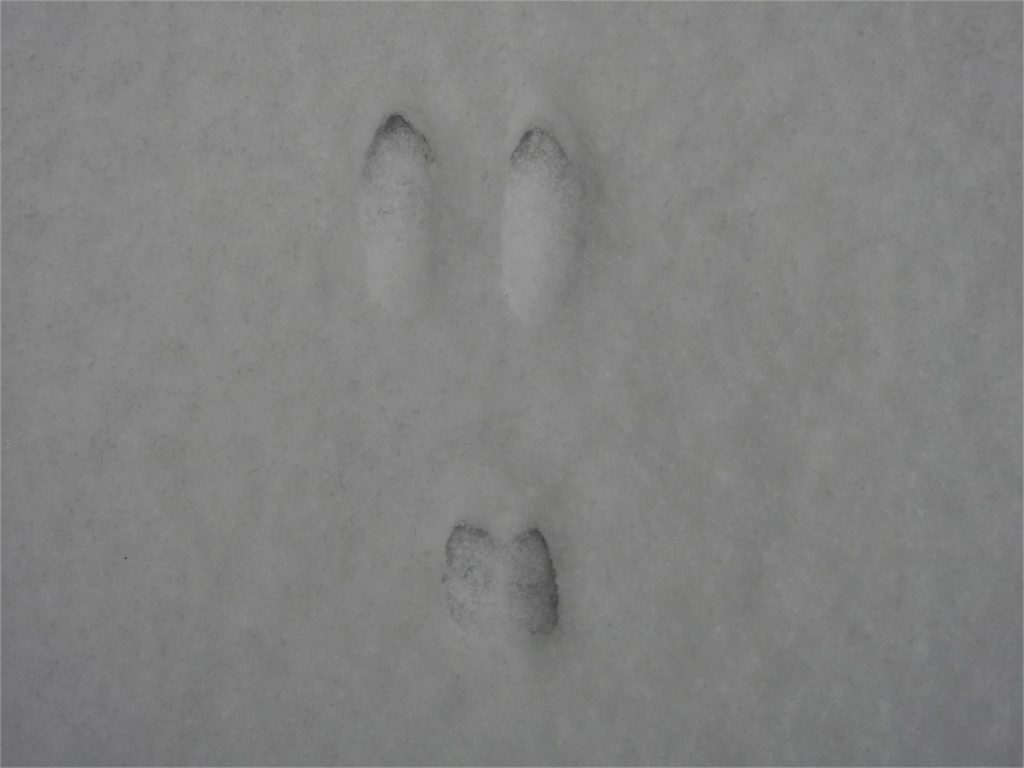

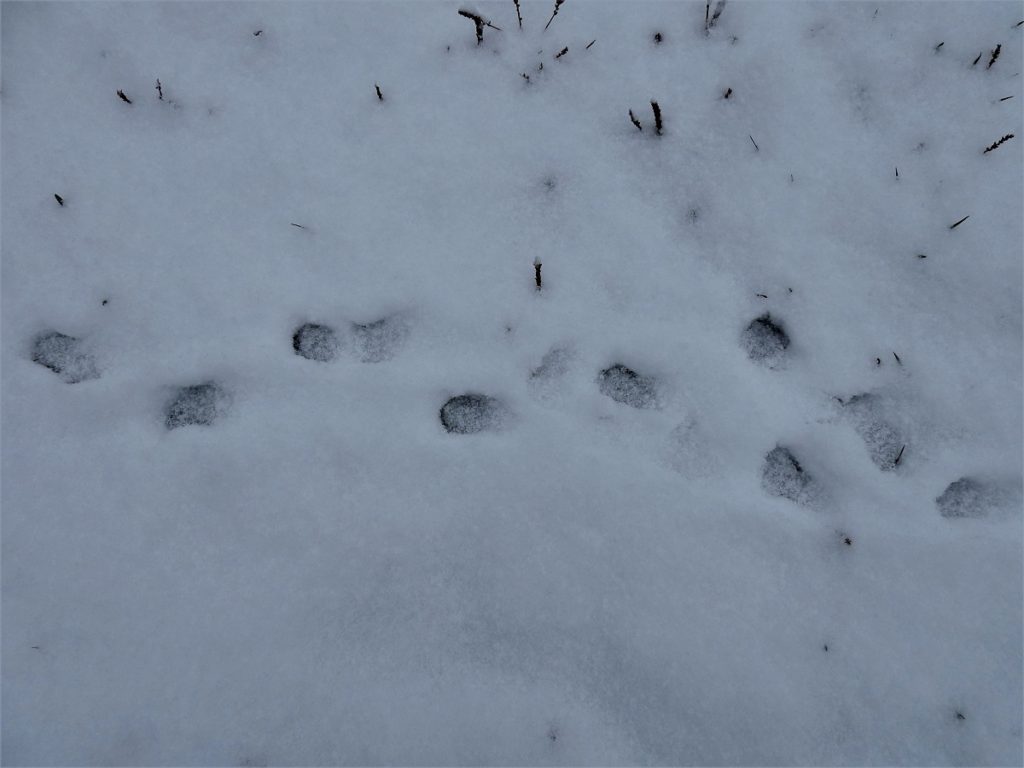
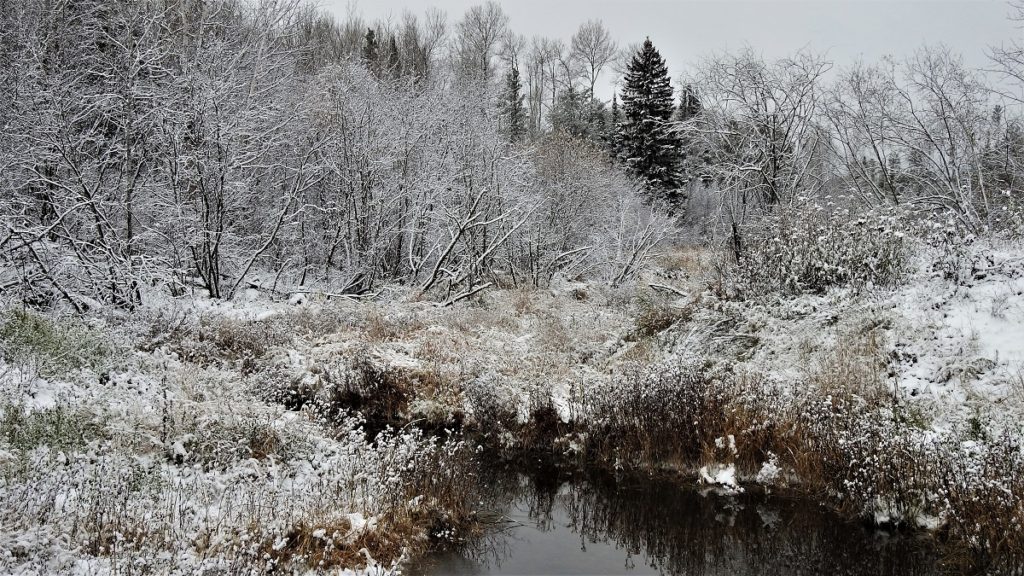

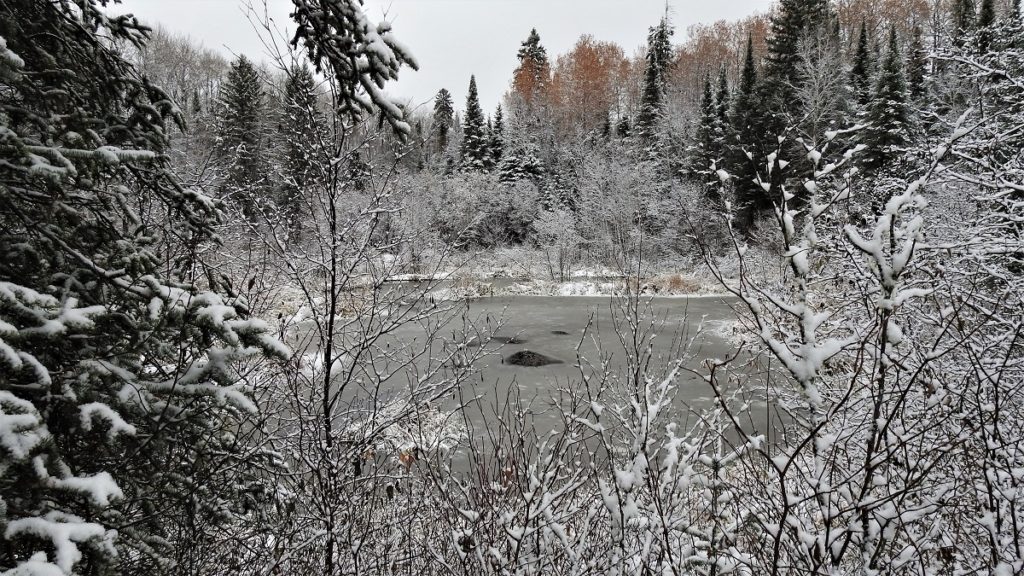
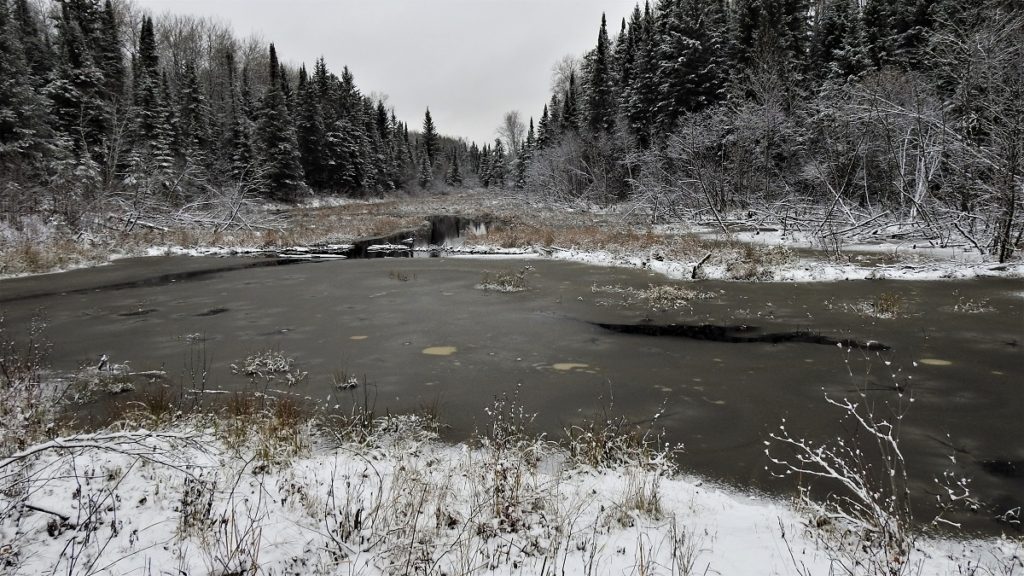
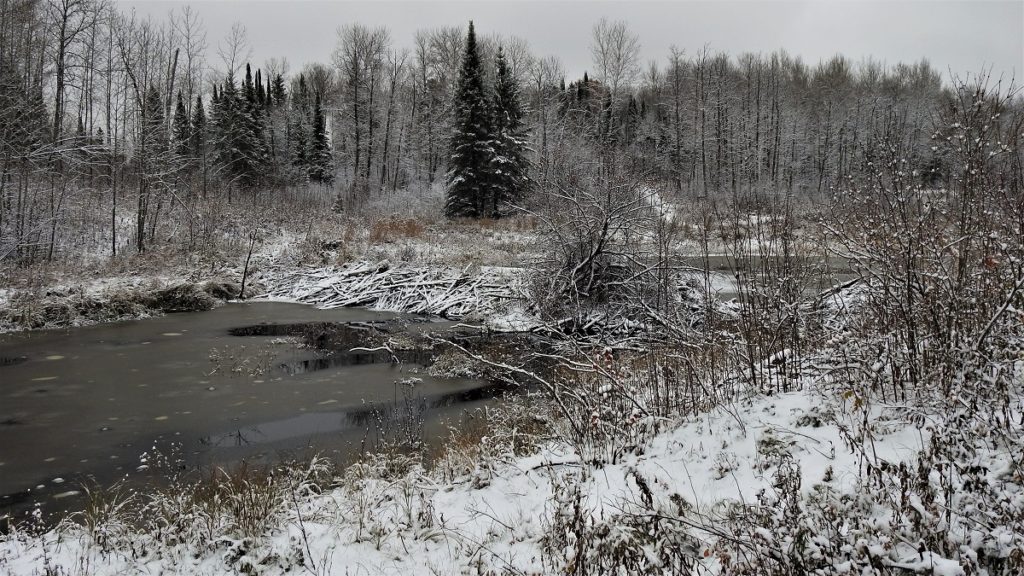

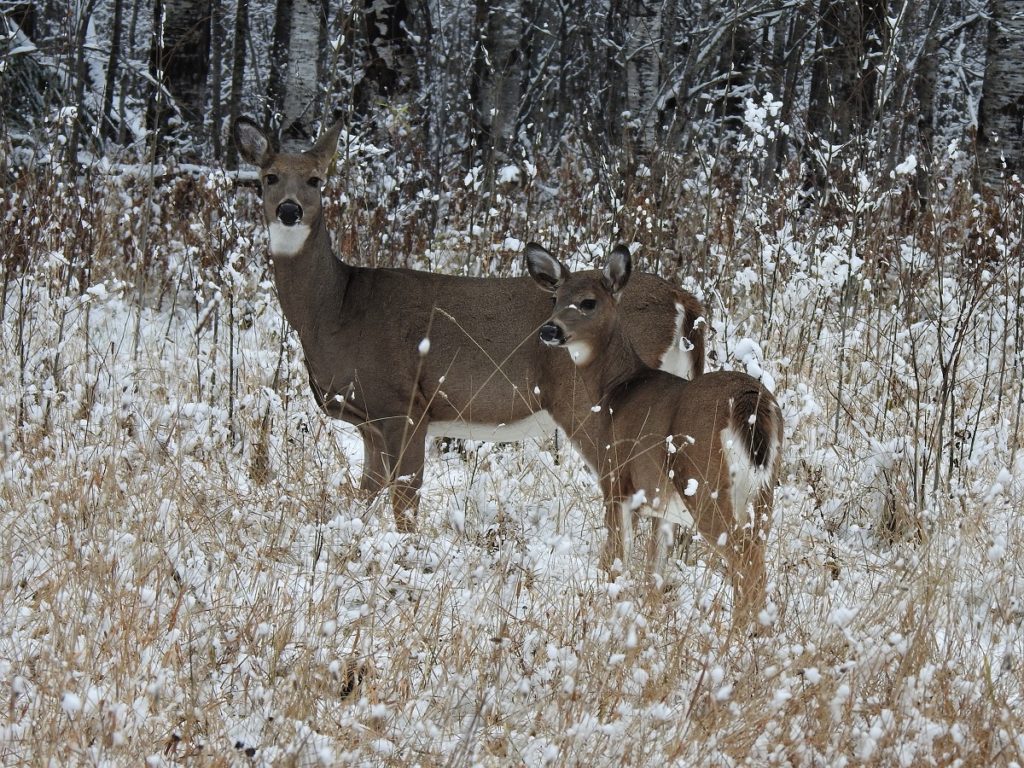
Early October Snow Robert Haight
It will not stay.
But this morning we wake to pale muslin
stretched across the grass.
The pumpkins, still in the fields, are planets
shrouded by clouds.
The Weber wears a dunce cap
and sits in the corner by the garage
where asters wrap scarves
around their necks to warm their blooms.
The leaves, still soldered to their branches
by a frozen drop of dew, splash
apple and pear paint along the roadsides.
It seems we have glanced out a window
into the near future, mid-December, say,
the black and white photo of winter
carefully laid over the present autumn,
like a morning we pause at the mirror
inspecting the single strand of hair
that overnight has turned to snow.

Winter Finch Forecast 2020-2021
For those of us who feed birds throughout the year, but especially during winter, we are always curious about what birds might be appearing at our feeders. For the past 20 years, Ron Pittaway has been making predictions for us with his Winter Finch Forecast.
While working as a naturalist in Algonquin park, Ron Pittaway began to make the connection between summer berry crops and cone crops of cedars, spruces, and pines and the abundance, or scarcity, of winter finches (pine siskins, crossbills, grosbeaks, and redpolls). In years of poor food supplies in the boreal forest, there are usually major irruptions if these species into southern Ontario and the northern U.S, beyond their typical range. In 1999 he began publishing his annular Winter Finch Forecast for the upcoming winter. At first predictions were based on mainly on observations from Algonquin Park and nearby areas, but as the years passed by, he was able to get observations from many contributors from across Canada and Alaska. His forecast became the staple of birders everywhere. For further information about how he developed his predictions, read this article at All About Birds.
Ron retired this year, and passed the torch to Tyler Hoar. Tyler is not a stranger to the Rainy River District. He has conducted bird surveys here, and has led several field trips in the District for the Ontario Field Naturalists His winter forecasts will appear on the Finch Network website.
General Forecast 2020-2021
It appears to be good year for several species. Cone crops on average are poor to from Lake Superior eastward but are fair to excellent west from Lake Superior, suggesting a good year here for crossbills and siskins. White birch crops are poor to fair across the boreal forest implying a flight of redpolls south. Purple Finches and Red-breasted Nuthatches in the east are currently moving south in numbers. Common Redpolls and Evening Grosbeaks have already been reported in New Mexico and Florida, respectively (Read more about this here).
Pine Grosbeak: There should not be a flight of Pine Grosbeak south this winter. Small movements of grosbeaks wandering from areas with a poor crop in search of areas of better berry crop may provide birders with small numbers of the species outside the boreal forest.
Purple Finch: Most Purple Finches will migrate south out of Eastern Canada this winter.
Red Crossbill: Red Crossbills are currently fairly widespread in Central Ontario to southern Maritimes and northeastern states mainly feeding in areas of heavy white pine crop. Red Crossbills should shift southward some as the white pine crop is depleted.
White-winged Crossbill: The Crossbill Pendulum has swung west for the winter of 2020-21. An excellent crop of White and Black Spruce from northwestern Ontario to Alaska should contain the majority of White-winged Crossbills this winter.
Common and Hoary Redpolls: The White and Yellow Birch crop is poor to fair throughout most of the boreal and southern Canadian forests. If the redpolls move on from the Swamp Birch crop, which has been reported to be good in northeastern Ontario, expect a moderate to good flight south out of the boreal forest.
Pine Siskin: Large numbers of siskins are currently being reported in areas with excellent spruce crops in the western boreal forest. The siskins likely will remain concentrated in Western Canada with its heavy spruce cone crops for the winter.
Evening Grosbeak: Evening Grosbeak appear to be on the move this winter. Its breeding population appears to be increasing in Eastern Canada westward to Manitoba due to increasing outbreaks of spruce budworm with large severe outbreaks in eastern Quebec.
For the complete forecast go to the Finch Network website.
Project Feeder Watch
An enjoyable winter activity is counting birds in your yard and contributing those sightings to Project FeederWatch, which is an important way for us to contribute to a continental data-set of bird abundance and distribution. This provides crucial information for scientists studying population trends.
This year the season runs from November 14 through April 9. No special skills are required, just a willingness to spend two days each week, for as long as you wish, from a few minutes to all day, watching your feeders. in fact, you don’t even need to put up feeders – just watch the birds in your yard for a few minutes. All the information you possibly would need and how to join can be found at Project FeederWatch.
In Canada Project FeederWatch is organized by Birds Canada. To participate a tax-deductible donation of any amount to Birds Canada is required. If you give $50 or more, you will also receive the BirdWatch Canada magazine. Contributions cover the cost of materials, staff support, data analysis, and so on.
Project FeederWatch is a joint research and education project of Birds Canada and the Cornell Lab of Ornithology.
Morning Reflections
During this unsettled and stressful time, it is easy to forget what is truly meaningful. This was brought home to me this morning, as I was walking along the creek below my cabin looking for Swamp Sparrows. I’ve been doing this for the last several days keeping track of when they and other lingering sparrows finally leave the area, most for the southern United States, others as far as Central America. It was a beautiful, crystal clear morning with the sun just beginning to rise above the horizon, infusing the tops of the trees around me with a pinkish glow. The reflections of those trees in the creek was stunning, and it made me instantly forget the weight of the world bearing upon our shoulders. I’ve walked along the creek many times before; it’s pretty, at least to me, but I’ve become accustomed to the view, and now it seems commonplace. But today it seemed to be the most beautiful place in the world. I wouldn’t have wanted to be anywhere else. The reflections made me look at the scenery in an entirely different manner, and it reminded me that beauty is always around us, and those cares suddenly seemed, for a time, anyway, of little or no importance. All of the following photos are reflections, except one. Now, pretend you are a child again, bent over, looking at the world with your head peering through your legs. The world will no longer seem the same.

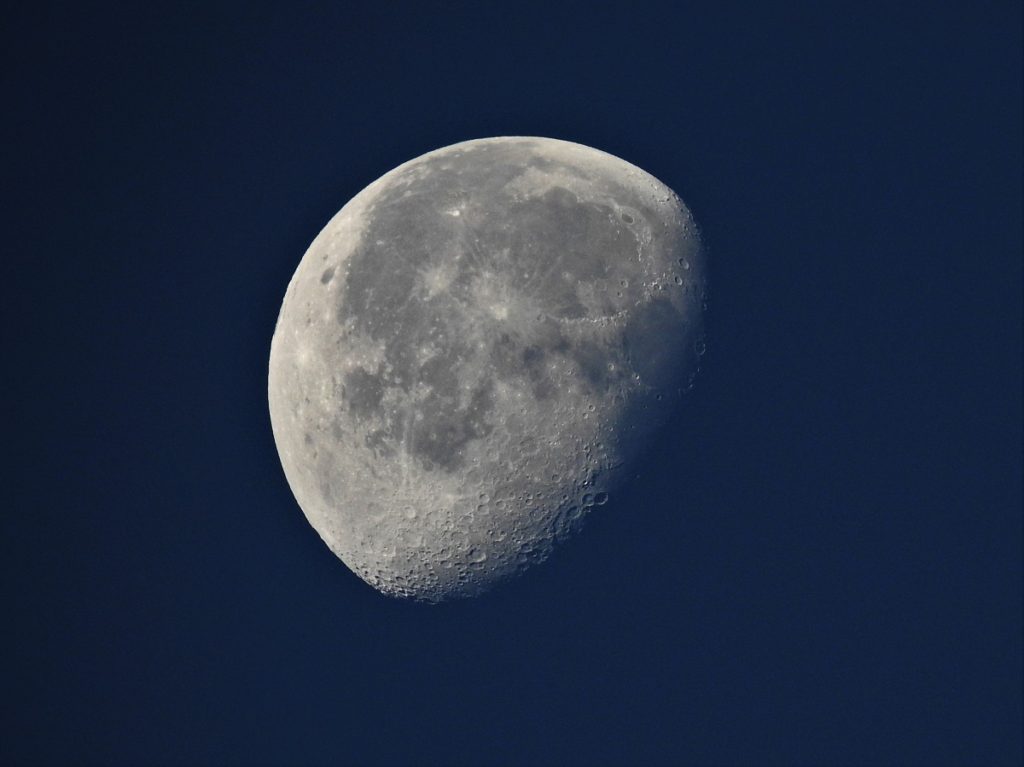
Which is the reflection?
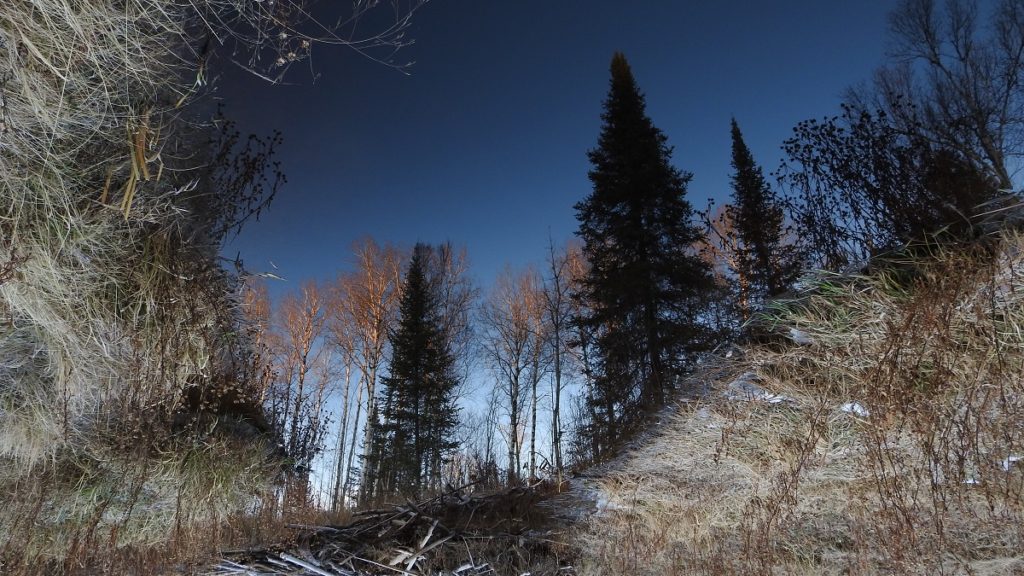
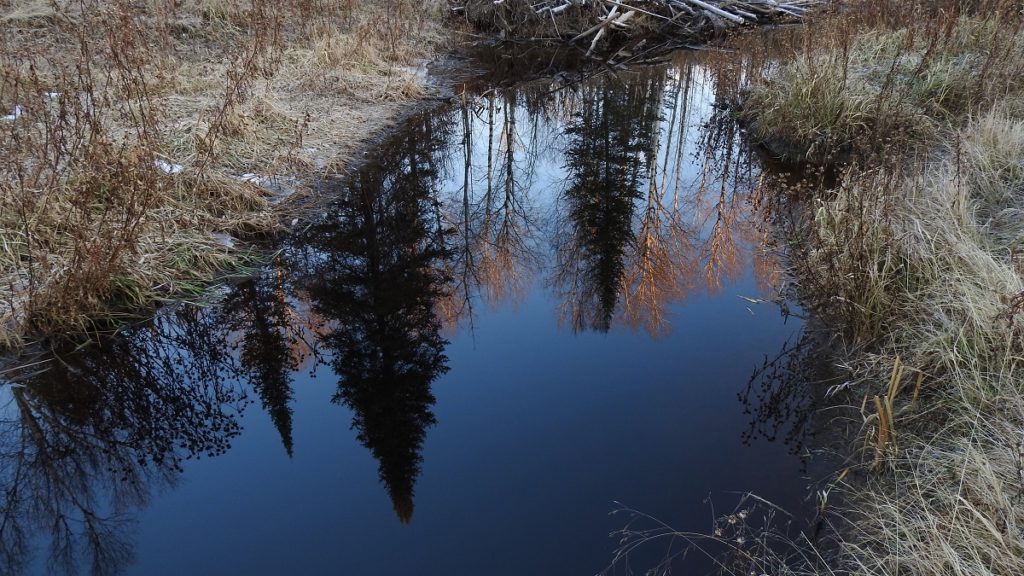
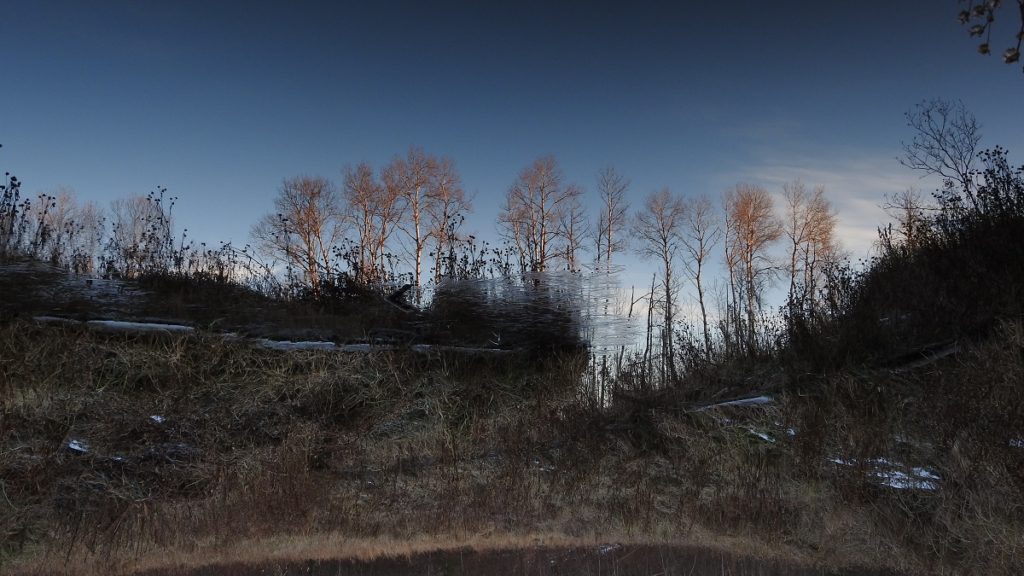



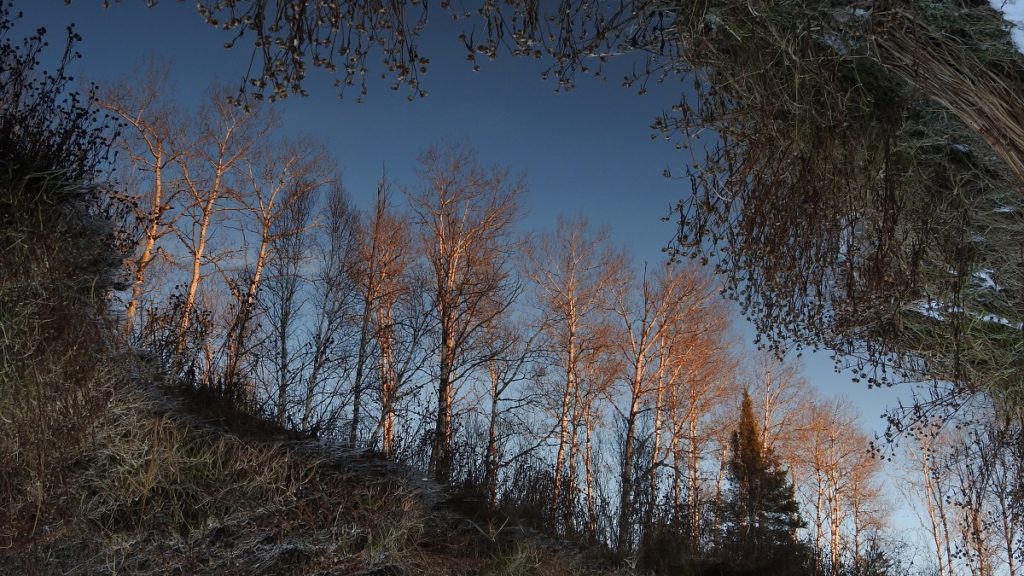
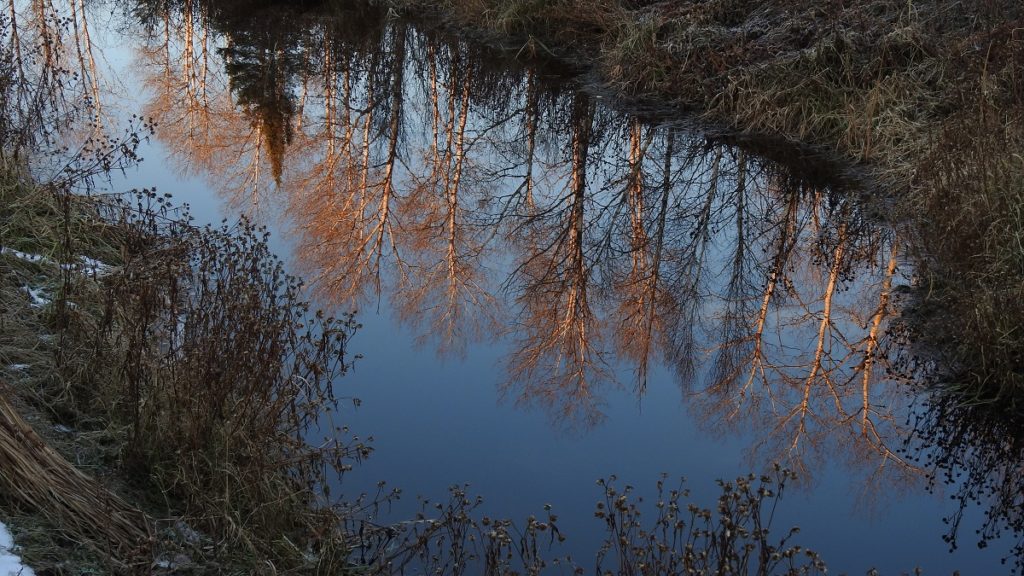
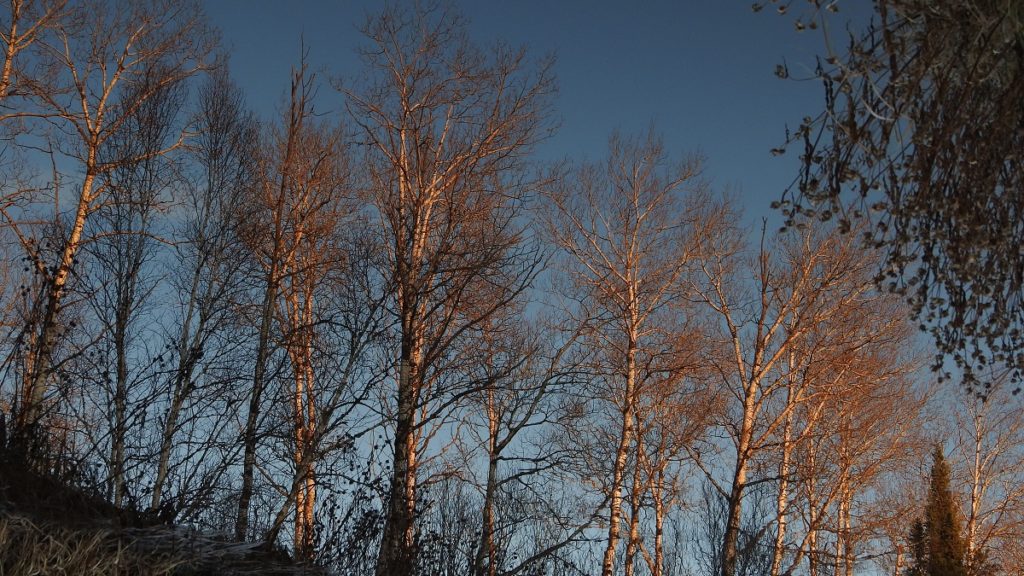
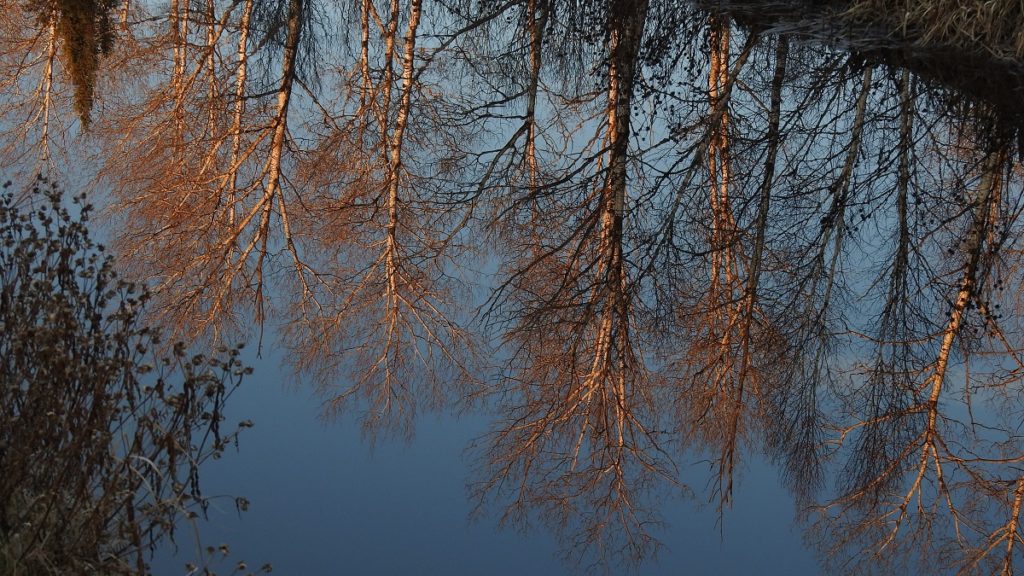

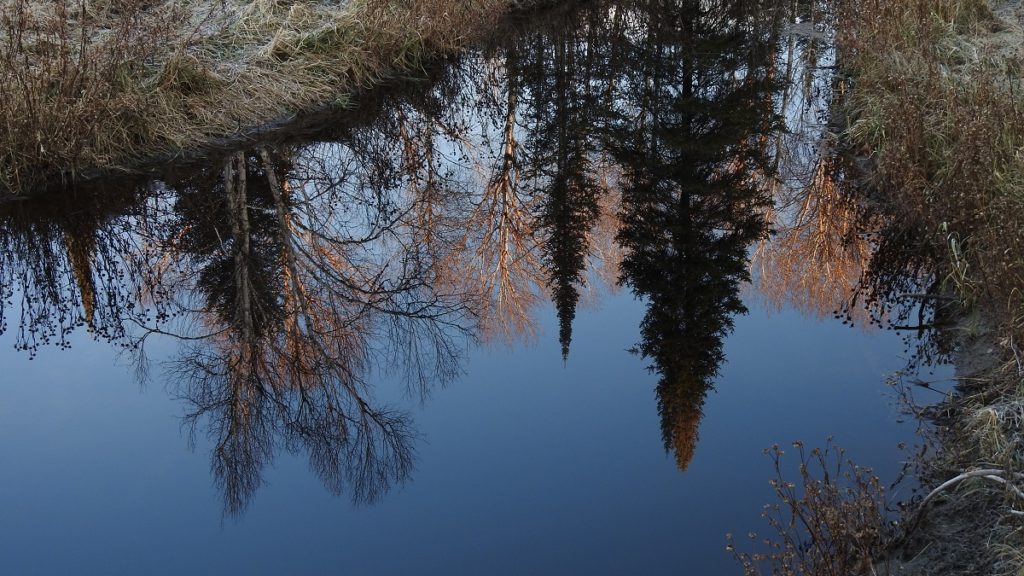
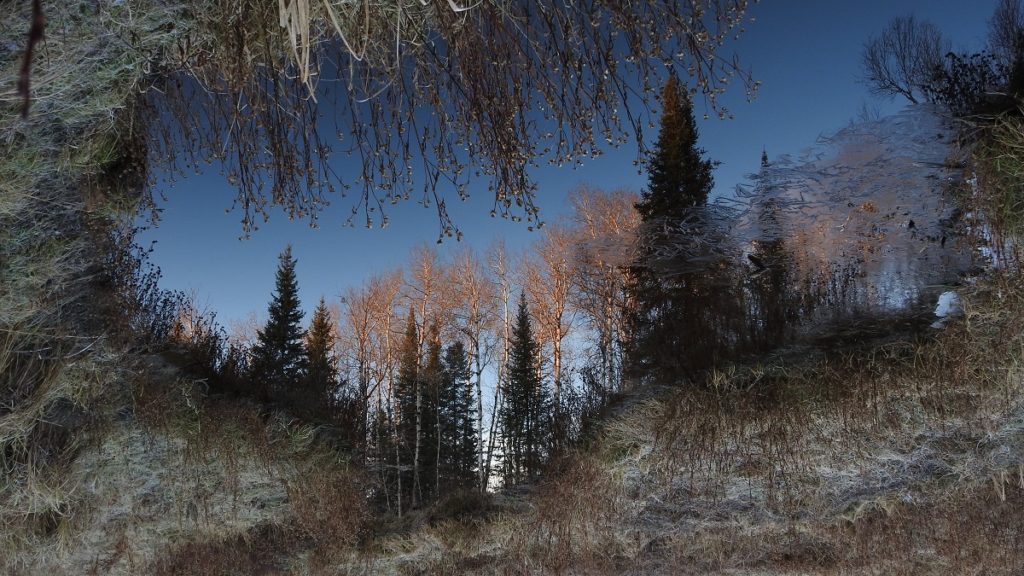
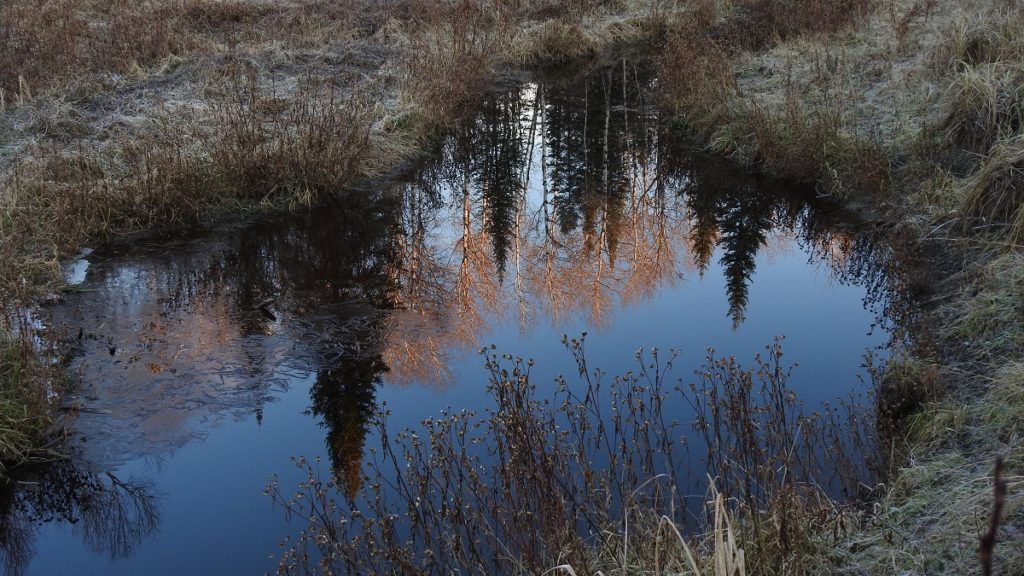
Fall Bird Roundup
Although the Thunder Bay Field Naturalists have been conducting the Fall Roundup for many years, this was the first year that the RRVFN has contributed as a group. This year the count was held on November 7th, this being the first Saturday in November, and the latest day in November that it could be held. Several of our observers noted a definite decline in the numbers from the beginning of the week to the actual date of the count. Especially notable was the departure of several sparrows, notably American Tree Sparrows, Fox Sparrows, and Swamp Sparrows. By November 7th there were only a few Dark-eyed Juncos and White-throated Sparrows left. The main migration of Snow Buntings had passed us by, but we also were beginning to welcome our winter visitors, Pine and Evening Grosbeaks, Common Redpolls, Pine Siskins, and Bohemian Waxwings. Last year it took quite a bit of searching to find any of those, so it will be interesting to watch through the winter to see if they remain in our area or continue heading further south.
We were quite lucky to have mostly excellent weather for the count week; a couple days we were even able to go birding in our shirts and shorts, if we wanted to.
Some interesting sightings included three species of owls (Great Gray, Great Horned, and Barred – all on the actual count day); a Long-tailed Duck (last seen in the Rainy River District in 2016); large numbers of Bufflehead and Hooded Mergansers (especially on the NW Bay of Rainy Lake); Pine Grosbeaks, Bohemian Waxwings and American Robins all gorging themselves on a single ornamental crabapple tree in Emo, and several sightings of Northern Shrikes, which Sallee and Vance were able to note why they are also known as “butcher birds”. They found a dead Black-capped Chickadee that had been cached on a bush, presumably by a shrike.
As a group we found 56 species during the count week and 37 species on November 7th, the actual day of the count. Overall, 84 species were recorded on the 7th for all of NW Ontario. Reports were submitted from Atikokan, Dorion, Dryden, Kakabeka Falls, Marathon, Pearl, Pigeon River, Rainy River, Raith, Sioux Lookout, Sunshine, Terrace Bay, and Thunder Bay. For the entire list for NW Ontario (Excel file), CLICK here.
Thanks to the following for a successful and fun week of birding: Gaby, Sallee and Vance, Bobbie, Ahlan, Ilka, Henry VA, Henry M, Randy, Michael, Joan, and, if it’s all right to thank yourself, Bob. The photos were all taken during the count week or very close to it.
